New Secretary-General-elect of the International Transport Forum: José Manuel Viegas

Source: International Transport Forum
Photo: International Transport Forum
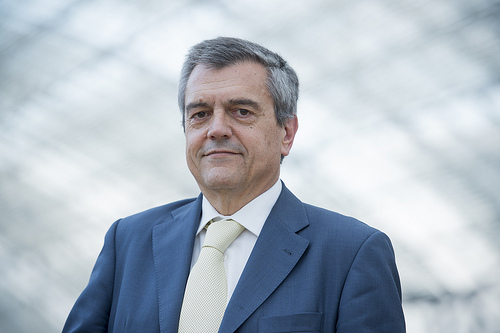 Paris/Leipzig, 3 May 2012 – Professor José Manuel Viegas, one of our members, has been chosen as Secretary-General-elect of the International Transport Forum, an intergovernmental organisation within the OECD family that acts as a global transport policy think tank.
Paris/Leipzig, 3 May 2012 – Professor José Manuel Viegas, one of our members, has been chosen as Secretary-General-elect of the International Transport Forum, an intergovernmental organisation within the OECD family that acts as a global transport policy think tank.
At their Annual Summit in Leipzig (Germany), Ministers from the 53 member countries of the Forum chose Viegas as the next chief executive of the organisation. Viegas is expected to take up office this summer, taking over from Michael Kloth of Germany, who led the Forum as Acting Secretary-General since November of last year.
Secretary-General-elect Viegas said: “I am grateful to the Ministers for electing me as the new Secretary-General of the International Transport Forum. I look forward to make it a prime example of ‘network governance’, to foster innovative transport policies based on solid knowledge.”
Professor Viegas comes to his new leadership position at the International Transport Forum from an internationally recognized career as an academic and consultant. He is a professor of civil engineering at the University of Lisbon and the chairman of Transport, Innovation and Systems s.a. (TIS.pt) a transport consultancy firm. Viegas has worked in all transport modes and with numerous international organisations. In his career, he has frequently launched and managed collaborative networks across different countries as well as across different economic sectors engaged in transport issues. Viegas has also been responsible for technical, organisational and financial innovations in his projects. He also has a long and distinguished history of collaboration with the International Transport Forum and its precursor, the European Conference of Ministers of Transport.
¿Comments? ¿Opinions? ¿Similar News? Send them to us!
Tweet
Transportation and the New Generation: Why Young People are Driving Less and What it Means for Transportation Policy

Source: Center for Transportation Research News – The University of Texas at Austin
A new report released by the U.S. Public Interest Research Group Education Fund and the Frontier Group demonstrates that Americans have been driving less since the middle of last decade. The report, Transportation and the New Generation: Why Young People are Driving Less and What it Means for Transportation Policy, shows that young people in particular are decreasing the amount they drive and increasing their use of transportation alternatives.
Transportation and the New Generation reveals that for the first time since World War II, Americans are driving less. The report shows that by 2011, the average American was driving 6 percent fewer miles per year than in 2004.
This trend away from driving is even more pronounced among young people. The average young person (age 16-34) drove 23 percent fewer miles in 2009 than the average young person in 2001. The report also notes that a growing number of young Americans do not have driver’s licenses; from 2000 to 2010, the share of 14 to 34-year-olds without a license increased from 21 percent to 26 percent.
The full report can be accessed here.
¿Comments? ¿Opinions? ¿Similar News? Send them to us!
Tweet
Analyzing route choice decisions in Metro networks: A comparison between Santiago and London

Opinion Pieces: The Challenge for the Infrastructure New South Wales Chief

Opinion Pieces: since 2007, Prof. David Hensher has written an opinion column in the Australasian Bus and Coach magazine, where he monthly discusses a lot of different transport-related hot topics. In this section we are revisiting these columns.
June 2011
The New South Wales (NSW) Government recently announced the appointment of Nick Greiner as the Chair of Infrastructure NSW. This is a critical appointment to direct the turnaround of NSW’s reputation in infrastructure provision, especially in the transport sector. The biggest challenge that will be faced in Sydney is how to move forward to deliver good transport coverage and service frequency in the face of a government commitment to announced major rail passenger projects. If one were able to start with a clean slate and be mindful of getting started sooner than later, and getting some real political mileage that is value adding to the electorate, there is no doubt that this is best achieved by a focus on upgrading the road network and using this opportunity to start assigning a substantial part of the road network as dedicated roads to buses (similar to what we are seeing with the Brisbane busway system) (with the possibility in off peak periods of giving access to taxis and hire cars), in contrast to painted bus lanes which appear and disappear throughout the network, forcing buses into mixed traffic just when they are getting a time benefit. Crucially, however, one must ensure that such a network lines up with meeting the growing accessibility needs of commuters in particular, where the test is in terms of door-to-door connectivity on high frequency, high service capacity (so one can sit) public transport. One will have to deliver some of this in tunnels (which buses can use) given the loss of transport corridors over the years. If the Chair is already constrained by two expensive rail projects (the NW and SW railways), then the network approach should still be proceeded with to ensure that these large projects do not hinder the needs to provide coverage and connectivity for all of Sydney where it can make a difference. Overlaying all of this physical network development must surely be a rethink about the low cost of using cars, which is the nemesis for public transport, and in many ways the efficient and fair pricing of the car use can be a significant part of the public transport solution. I recently calculated that if we were not the build the NW and SW railways, we could purchase 28,500 new buses for the equivalent projected capital cost, increasing bus service capacity 7.5 times (and even allowing for the operating cost differences, this number could be as high as 4 times, still impressive). That would surely deliver massive accessibility benefits to all of Sydney! For the rest of NSW, the focus must be on completing the Pacific and Hume Highways as dual carriage throughout.
Food for thought
¿Comments? ¿Opinions? ¿Similar News? Send them to us!
Tweet
Brendan Finn visit to Pontificia Universidad Catolica de Chile

The PUC team received the visit of Brendan Finn the last week of March. Brendan Finn is a Civil Engineer with M.Sc. In Transport Engineering and Operations. He has worked for more than 30 years in the public transport sector, first with the public bus company in Dublin, Ireland, and since 1993 as an independent transport consultant. He specializes in public transport organization and operations, with particular interest in institutional and regulatory frameworks, operations management, BRT and ITS. He is currently working on BRT projects in Ghana and Philippines, and was co-editor of the EU COST Action Report on Buses with High Level Service (BHLS).
During his visit, he worked with the members of our Centre of Excellence, and also had the chance to present two seminars:
BHLS– Bus with High Level of Service: results on a study of BHLS in Europe.
Download presentation here
Organization and Regulation of Bus Transport – International Experience: comparative international study about:
– Roles and functions of passenger transport authorities
– Forms of regulation and market access
– Options for passenger transport institutions
Download presentation here
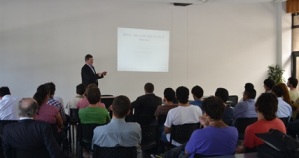
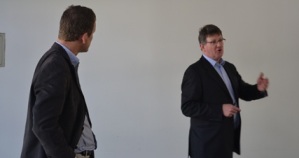
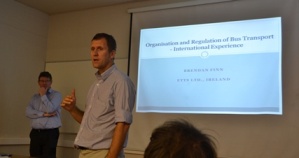
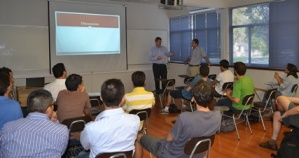
¿Comments? ¿Opinions? ¿Similar News? Send them to us!
Tweet
The Road Not Taken – Amman Bus Rapid Transit system

Source: Jordan Business by Hazem Zureiqat*
In three years of political turmoil and economic drift, Jordan has seen plenty of error. The decision to kill the Amman Bus Rapid Transit system is one such mistake. Hazem Zureiqat looks at the project’s inception. What went wrong and where do we go from here?
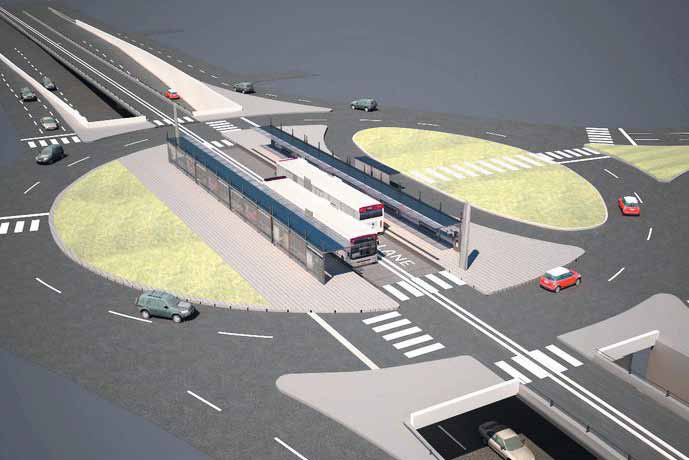
Rendering of GAM’s solution for the Press Tunnel. The BRT lanes will run on a raised structure above the tunnel and will then pass the intersection at street level. A BRT station will be located at the intersection.
Most of us have seen the abandoned two kilometers of bus lanes along Queen Rania Street. They are part of an ambitious 32-kilometer network of bus rapid transit (BRT). The Amman BRT project, known in Arabic as Al-Baas Al-Saree, has been a hot topic in the media and among the residents of Amman. Much has been said on the project and where it stands today, but truly understanding this particular issue requires taking a step back and looking at the bigger picture.
From Roundabouts To Rapid Transit
Urban transport planning, in its comprehensive and multi-modal context, has never really been part of the public discourse and policymaking in our part of the world. Some would even argue that this is the case for other forms of planning, be they physical or otherwise, but the absence of proper transport planning has been especially palpable in our oilrich region.
It is not hard to make out how this longstanding approach to doing things (or not doing them) has manifested itself in Amman. The city today is marred by countless bridges and tunnels. Sidewalks are, for the most part, ineffective, and pedestrian crossings are virtually non-existent. Public transport is in disarray, with over 70% of the fleet comprising of small service taxis or Coaster buses, many of which are individually owned and operated. With the rapid population growth the city has experienced, the size of our fleet of large buses remained constant between 2000 and 2010, after which an additional 116 buses were introduced. Meanwhile, car ownership levels in the city are increasing by an alarming 10% to 15% per year, even among households
with fairly low levels of income. At the same time, more than half of the city’s population is under the age of 25; add to that the increasing rate of female participation in the labor force, and what you get is nothing short of an explosion in future transport demand that no road widening, bridge or tunnel would be able to accommodate.
So, how did we get here? Firstly, we have been relying for too long on cheap oil from our neighbors, so building roads and importing more cars was the way to go, not just in Amman, but at the national level as well. Secondly, the institutional set-up was not designed to give the right incentives for policymakers at the municipal and national levels to think more systemically.
In Amman, traffic engineering and operations tasks, in addition to spatial and land-use planning, fell under the responsibilities of the Greater Amman Municipality (GAM), while public transport planning and regulation was under a different entity working at the national level, the Land Transport Regulatory Commission. Coordinating both functions was not easy across different bureaucracies.
Today, things have changed. We no longer have access to cheap oil – or at least not to the same extent as we did prior to the 2003 US-led invasion of Iraq. Prime Minister Awn Khasawneh recently reiterated this point in an interview on Jordan Television’s 60 Minutes. The premier cited the large number of cars that enter the Kingdom each year, adding that meeting the energy bill has become Jordan’s primary economic challenge.
The weak institutional set-up – the second reason listed above – has been addressed and we now have the right framework to think and plan in a more integrated fashion. In 2007, planning and regulation of public transportation within Amman became part of GAM’s responsibilities, and today GAM has one integrated Transportation Planning Department that deals with all modes of transport, from private cars to public transportation and pedestrians. More and more, decision makers and staff at GAM are becoming well aware that the problem in Amman is about moving people and goods, not just cars, and that our transport system needs to be more balanced and multi-modal and should be planned accordingly – all while taking into consideration changes in land use and zoning.
The question becomes then: what has happened since the institutional changes of 2007? GAM developed a Transport and Mobility Master Plan (TMMP) that outlined the city’s mobility needs for the period leading up to 2025. The study involved conducting a survey of around 10,000 households to assess their transport behavior. That survey, along with extensive traffic and public transport data collection across the city, created a rich database that formed the basis of the Amman transport model, a powerful planning tool that integrates transport, land use and socio-economic data.
As the outcomes of the TMMP began to emerge, it became clear that the city needed a higher order, namely a more rapid public transport mode. Several options were analyzed, and BRT emerged as the preferred option for Amman due to its low cost, effectiveness and relative ease of implementation given the city’s hilly terrain. BRT is a term used to describe public transport systems in which buses run on a segregated right-of-way, essentially offering a service similar to that of trains (but, clearly, at a fraction of the cost). A BRT lane in Amman can accommodate more than three times the number of people in a regular traffic lane. BRT was first implemented in Curitiba, Brazil in 1974, and has since been successfully constructed in over 120 cities worldwide. Often cited as one of the most successful examples, the BRT system in Bogotá, Colombia, has a current capacity of 45,000 passengers per hour in each direction, which is higher than the capacity of most metro systems worldwide.
Amman BRT And The Perfect Storm
In early 2009, GAM commissioned a comprehensive study to develop the BRT scheme for the city. The study aimed to first validate the BRT network developed under the TMMP and then to develop the complete service and operations plan for the system (in terms of number of buses required, frequencies of service, etc.). This would be followed by estimating the demand and revenue forecasts and operating costs; preparing an economic feasibility study and an environmental impact assessment; and finally, developing the detailed engineering designs for the infrastructure, from bus lanes to stations and terminals. Focus groups were held to obtain a better understanding of the problems people face when using different modes of transport. An additional survey was carried out at the University of Jordan, one of the key nodes along the BRT network, to ascertain what students felt they needed in a new public transport system.

Rendering of the BRT station by the University of Jordan. This is the only underground station along the 32-km network.
As the economic and financial appraisal of the BRT began, work on developing the infrastructure design was undertaken in parallel. It was clear at the outset that the engineering design of a 32-kilometer network of exclusive bus lanes would be a challenge given the large number of grade-separated intersections (i.e. intersections with multiple levels) in Amman. Starting that process early on was, therefore, essential. As is the case with such complex projects, an iterative approach was adopted, so designs were constantly discussed and revised as work on other streams progressed.
Contrary to what many seem to believe, intersections such as the Press Tunnel and Sports City were tackled early on. Alternative solutions were analyzed based on various criteria, such as the level of BRT priority, accessibility to passengers, construction costs and impact on traffic during both construction and operations.
Throughout this entire process, the French Development Agency (AFD) was heavily involved in the appraisal of the project to ensure its feasibility, both economically and financially. After conducting a thorough financial audit for the municipality, the AFD and GAM signed a credit facility agreement under which the AFD would provide a $166 million loan to GAM to fund the construction of infrastructure for the Amman BRT. This was a soft loan that was offered directly to GAM with no sovereign guarantee from the Government of Jordan. It demonstrated AFD’s faith in the project and in GAM’s ability to pay off the loan in due course.
After detailed designs were completed for some sections along the BRT network, GAM began tendering out construction works. Construction of the first two kilometers along Queen Rania Street began in July 2010, and was completed the following year.
As the first package of BRT was being constructed, there was an unexpected turn of events. In May 2011, some members of parliament called for the BRT to be suspended. Some said it was a “failure” while others deemed it “unsuitable for Amman”. At the end of following month, then prime minister Marouf Bakhit formed a ministerial committee to reassess the project. During the same period, a number of media outlets, including a prominent daily newspaper, attacked the project as a corrupt and failed endeavor. The Audit Bureau, which had previously offered its seal of approval along various stages of the project, issued a report saying the BRT was “not feasible”. Not surprisingly, since the report was issued by an entity whose responsibilities never included preparing feasibility studies, the report lacked the basic elements of such studies and was erroneous in many respects, according to technical staff at GAM.
Meanwhile, the ministerial committee conducted a comprehensive review over the course of two months, looking at technical, financial and environmental aspects of the project. It issued a very positive assessment of the scheme and clearly stated that there was no evidence of corruption. This assessment was sent to the Cabinet of Ministers, which issued a very brief, weasel-worded decision on September 10, 2011, to temporarily suspend all construction works on the project pending further independent review. As of the date of this writing, this review has yet to take place.
It is difficult to frame such a bizarre turn of events within a rational context. Developments across the region took policymakers in Jordan by surprise. The decision-making process, already distorted at the time due to the lack of political reforms, became even more crippled. A haphazard fight against corruption put everyone and everything under question, creating an environment in which decision makers opted for stalling or adopting a more populist approach rather than performing their managerial duties as public officials.
The Amman BRT and perhaps GAM as an institution were easy targets. The biggest losers in all of this, however, are the people of Amman. Our ability to move around the city is at stake, and we should not remain silent.
* Hazem Zureiqat is a transport consultant working for Engicon, a multidisciplinary engineering consulting firm based in Amman. Prior to joining Engicon, he was part of GAM’s core transport planning team.
¿Comments? ¿Opinions? ¿Similar News? Send them to us!
Tweet
Interview to Carlos Daganzo: "The bus is cheaper and more eficient than the subway" (in Spanish)

Source: La Vanguardia
Photo by Jordi Roviralta
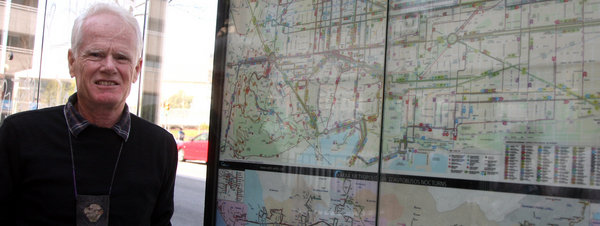 La mejor solución no es la más cara, pero al político mediocre – recuerda Carlos Daganzo, director del UC Berkeley Center for Future Urban Transport en University of Califoria, Berkeley; honoris causa por la Universitat Politècnica de Catalunya – le encanta el gran presupuesto y las inauguraciones de postín tras obras titánicas. A algunos ciudadanos también, pero todos estamos aprendiendo. La línea 9 del metro de Barcelona se presupuestó en 3.000 millones de euros y hoy – tras el error del Carmel y con tribunales de por medio – ya supera, según la conselleria, los 7.000 millones. Por eso resulta tan refrescante como insólito el sentido común del ingeniero Daganzo, autoridad mundial en transporte, cuando anuncia el fin de las obras sin fondo, porque con 200 humildes buses más, bien gestionados, Barcelona ya tendría su movilidad servida. ÉL nació en Barcelona, pero estudió y trabaja en E.E.U.U.
La mejor solución no es la más cara, pero al político mediocre – recuerda Carlos Daganzo, director del UC Berkeley Center for Future Urban Transport en University of Califoria, Berkeley; honoris causa por la Universitat Politècnica de Catalunya – le encanta el gran presupuesto y las inauguraciones de postín tras obras titánicas. A algunos ciudadanos también, pero todos estamos aprendiendo. La línea 9 del metro de Barcelona se presupuestó en 3.000 millones de euros y hoy – tras el error del Carmel y con tribunales de por medio – ya supera, según la conselleria, los 7.000 millones. Por eso resulta tan refrescante como insólito el sentido común del ingeniero Daganzo, autoridad mundial en transporte, cuando anuncia el fin de las obras sin fondo, porque con 200 humildes buses más, bien gestionados, Barcelona ya tendría su movilidad servida. ÉL nació en Barcelona, pero estudió y trabaja en E.E.U.U.
¿Para qué sirve el tranvía en Barcelona?
El tranvía es menos eficiente que el autobús: es obvio que todo lo que hace el tranvía lo puede hacer el bus, pero no todo lo que hace el bus lo puede hacer el tranvía.
Entonces, ¿qué ventaja tiene el tranvía?
Sólo la estética o la tradición.
La mejor tradición es optimizar gasto.
Pues entonces, el bus es hoy en Barcelona la mejor opción: más eficiente y barato que el tranvía y mucho más que el metro.
¿Más eficiente que el metro?
El bus moderno bien gestionado, con las tecnologías de información on line y modelaje aplicadas al tráfico, es mejor que el metro.
Además te evita ser un triste topo.
Y el metro también es menos democrático que el bus, porque sus escaleras discriminan a los mayores, que temen sus largos -e inseguros- trayectos en el subsuelo.
A menudo con motivo.
Y eso sin citar el enorme impacto ambiental de las costosas y molestas obras del metro, con sus desviaciones presupuestarias.
La línea 9 iba a costar 3.000 millones de euros y ya pasa de los 7.000 millones…
Nos ahorraremos impuestos en evitar obras así, porque el bus moderno bien gestionado no requiere grandes infraestructuras y presta mejor servicio que el del metro.
A mí ya me habían convencido de que el metro era caro, pero insustituible.
Hoy Barcelona tiene 900 buses: con 200 más, cubriría su demanda de movilidad.
¿Más buses no son más atascos?
Sólo si se gestiona mal el tráfico. Y esa es mi especialidad. Hoy el diseño inteligente de sistemas de tráfico hace del bus la opción más eficiente en movilidad urbana.
¿Por qué se nos presenta entonces el metro como la única alternativa?
Supongo que a los políticos les luce más el gran presupuesto y la inauguración de campanillas que la humilde línea de buses.
La tecnología acaba siendo política.
Las soluciones para la movilidad urbana son consecuencia de conciliar posibilidades tecnológicas con decisiones políticas. Yo soy ingeniero e investigo y ofrezco soluciones tecnológicas, pero es el ciudadano quien debe elegir al político honesto que las entienda y ponga en práctica.
¡Pero en un metro cabe más pasaje que en un bus: el convoy es más largo!
El bus moderno también puede engancharse y desengancharse en convoyes y, además, de forma más flexible que el metro, limitado a ir por vías inamovibles.
¿Qué más han inventado ustedes?
También diseñamos paradas en tándem.
¿Cómo son?
Los autobuses circulan en convoy por una línea principal y al llegar a determinadas paradas en tándem, los viajeros se cambian de línea a otra secundaria: las combinaciones para lograr la plena eficiencia son infinitas.
¿Y todos esos buses más, sin atascos?
Es posible con un tráfico inteligente. El carril bus, por ejemplo, no debe estar reservado siempre para el bus. Lo podrían utilizar todos por turnos: un sistema de semáforos podría avisar de cuándo llega un bus y los coches saldrían del carril sólo entonces…
¿Y si los conductores no se apartan?
… Es que si no se apartan, el bus lleva una cámara que fotografía a los infractores.
Entonces, seguro que se apartan.
No basta: un sistema inteligente requiere la complicidad de una ciudadanía inteligente. Hoy, por ejemplo, el ciudadano le exige al autobús una parada muy próxima, pero si aceptara menos proximidad, el bus podría tener más frecuencia y mayor velocidad comercial, lo que haría más breve su trayecto.
El vecino andaría un poco más -que le irá bien-, pero llegaría antes a su destino.
Para mejorar el tráfico privado hay que invertir más en el público. Incentivar, por ejemplo, el uso del bus en hora punta bajando el precio del billete -o subiendo el del parking- haría que todos circuláramos mejor.
Aun así, serían muchos buses y coches.
Pero hoy ya hemos diseñado sistemas para gestionarlos mucho mejor. Un brillante alumno mío, por ejemplo, hoy profesor en el Politécnico de Lausana, ha descubierto una fórmula crucial para evitar atascos: un hallazgo revolucionario.
¿Cómo?
Para evitar atascos sólo tienes que saber cuántos coches circulan por la ciudad en cada momento. Cuando ya lo sabes, puedes regular la entrada de vehículos modulando la duración de los semáforos de acceso.
¿Cómo logró establecer esa relación?
En gestión de tráfico hablamos de un efecto zoom. Cuando estás dentro del coche, parece que el tráfico no tiene lógica, pero si te subieras a un helicóptero, desde allí empezarías a verla y, desde más alto, percibes un sentido en las rutas cada vez más claro.
Como ver las hileras de las hormigas.
Ese zoom se logra con modelos matemáticos. Después, para calcular cuántos coches hay en cada momento, usamos el método de los ictiólogos para averiguar cuántos peces hay en un lago: pescas 30, marcas 3 y los liberas y, al volver a capturar los marcados, puedes extrapolar y deducir el total.
¿Y cómo marcas los coches?
En Yokohama calculan el número de coches en circulación gracias a los GPS de los taxis. Pero, en cualquier caso, para aplicar esas técnicas, necesitamos gestores capaces de entender los modelos matemáticos; sólo así sabrán aplicarlas y defenderlas.
¿Comments? ¿Opinions? ¿Similar News? Send them to us!
Tweet
From Here to There: A Creative Guide to Making Public Transport the Way to Go

Source: EMBARQ
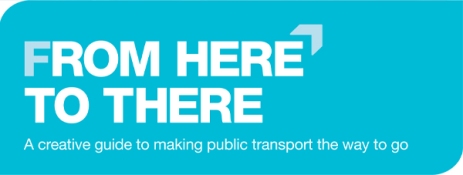 Major automobile companies spend billions of dollars annually to advertise their products to customers. In 2009, General Motors alone spent $3.2 billion on advertising campaigns and overall marketing efforts for their products. Major auto companies collectively spent $21 billion worldwide and it looks like their investments are working. The number of private vehicles in Brazil more than doubled in less than a decade — 1.2 million in 2001 to 2.6 million in 2010. India experienced a 20-fold increase in the number of private motor vehicles in the last decade.
Major automobile companies spend billions of dollars annually to advertise their products to customers. In 2009, General Motors alone spent $3.2 billion on advertising campaigns and overall marketing efforts for their products. Major auto companies collectively spent $21 billion worldwide and it looks like their investments are working. The number of private vehicles in Brazil more than doubled in less than a decade — 1.2 million in 2001 to 2.6 million in 2010. India experienced a 20-fold increase in the number of private motor vehicles in the last decade.
Such overwhelming statistics in favor of private vehicles, backed by billion dollar investments in advertising campaigns, point to the urgency with which public transport must catch-up in this competitive marketplace. Often times, so much energy is focused on the technical and financial aspects of getting public transit projects off the ground that branding and marketing become an afterthought.
In an attempt to give public transport a competitive edge, EMBARQ released a report on marketing and branding public transport. The reports aims to help guide cities and public transit agencies in making mass transit a competitive and desirable alternative to private vehicles. Titled, “From Here to There: A Creative Guide to Making Public Transport the Way to Go,” the report hopes to encourage cities and transit agencies to think critically and creatively about how to make public transport the preferred way to travel.
The purpose of the guide is to help transit agencies develop strong and successful strategies to achieve three important goals:
- Attract new users that currently use private transport, such as cars and motorcycles,
- Retain existing public transport users who might feel compelled to buy a private vehicle, and,
- Secure political and financial support from government officials.
By taking a cue from the private sector, which routinely and successfully influences consumer behavior, the report applies eight branding, marketing and communications tactics to the public transport sector.
- Brand and identity
- Internal communication
- User education
- User information systems
- Marketing campaigns
- Public relations and external communications
- User feedback systems
- Online engagement
“For some time, it has been clear that cities need to create high-quality public transport systems to improve the urban environment,” the report explains. “However, not until recently has it become clear that cities must also convince the public that these high-quality systems are in fact high-quality.”
The recommendations in the report are by no means prescriptive or exhaustive. The report is merely a starting point for exploring ‘best practices’ in the public transport marketing and branding world. With the launch of “From Here to There,” EMBARQ hopes to start an open dialogue that will enhance public transit and the very quality of our cities.
This report is only the beginning of our efforts in helping public transport become a stronger alternative to private vehicles.
Downloads Full Report:
- English (PDF, 29 pages, 4.42 MB)
- Português (PDF, 29 pages, 4.51 MB)
- Español (PDF, 29 pages, 4.41 MB)
¿Comments? ¿Opinions? ¿Similar News? Send them to us!
Tweet
Congress Brings Together International Experts on Urban Transport


«High Quality Urban Public Transportation for All,» is the goal of the 18 managing public transport agencies from seven Latin American countries, that today make up the Latin American Association of Integrated Systems and BRT – SIBRT. To achieve this goal, the Association with the support of the best organizations and experts from around the world, will meet from April 25-26 in the City of Leon, Mexico, during the Second Congress «Best Practices SIBRT in Latin America.»
The event, which will be held at Radisson Poliforum Plaza Hotel in the City of León, will also provide participants with the opportunity to get introduced to the most modern equipment and technologies of the public transport sector. In addition, a trade show will bring together key industry suppliers, thereby creating an excellent business environment.
Organized by SIBRT, and with the support from the Directorate of Mobility of the City of Leon, the City Hall of Leon, and EMBARQ Network, this event, in its second year, will address issues that have been prioritized by the major public transportation agencies in Latin America:
- Public Policy for Sustainable Transportation
- Financing the Integrated Transport Systems
- Road Safety of Urban Bus Systems
- Quality of Service and User Satisfaction
At the event, these issues will be addressed by internationally renowned experts, such as Felipe Targa Rodriguez, who will speak on the theme «Public Policy for Sustainable Transport in Colombia.» As Colombian Vice-Minister of Transportation, Targa has extensive experience in the transportation sector, especially the work of the National Planning Department of Colombia in the National Urban Transport Program; in addition to his important work at BID. Another expert, Luis Aparicio Gutierrez, Strategic Director for Latin America of EMBARQ Network and Executive Secretary of SIBRT, will address the issue of Public Policy, with a presentation titled «Notes for a Public Policy for Sustainable Transport in Latin America.» Also, O.P. Agarwal, Senior Urban Transport at the World Bank, will speak about the experience of public policy in India, as well as on the program of world leaders in urban transport driven by the World Bank.
On the theme, «Financing Integrated Transport Systems,» an expert Julian Sastre, Engineer, Vice-President of the Forum of Infrastructure and Services of Spain, will speak on «Lessons of Experience and Challenges in Europe». In the same session, the Latin American experience will be highlighted with the presentation of the Brazilian agencies URBS, from Curitiba, BHTrans, Belo Horizonte, in addition to Transantiago, from Santiago, Chile. The General Manager of the Transmilenio, and President of SIBRT, Carlos Garcia Botero will also present a lecture on «Financial Model of the Integrated Transport of Bogotá.»
In the session titled «Road Safety of Urban Bus Systems,» Brenda Medeiros, Transport Coordinator of EMBARQ Brazil, will present a «Summary of Best Brazilian Experience in Road Safety for Bus Systems: Conclusions and Plan of Action from the Workshop of the Brazilian Chapter of SIBRT.» On the same theme, experiences and programs adopted by the agencies Protransporte, from Lima, Megabus, from Pereira, and Metrobus, from Mexico City will be presented.
Another important theme “Image of the BRT Systems,” that has gained prominence among the managers of public transport is relevant to the image of BRT (Bus Rapid Transit). Therefore, the Organization has planned a special session in which the issue will be addressed by experts. The presentations will be given by Rejane D. Fernandes, Director of Strategic Relations and Development of EMBARQ Brazil and SIBRT´s Senior Advisor, who will speak on «Brazilian Experiences in Marketing for BRT,» and Angelica Vesga, Communications Director of EMBARQ / CTS Mexico, who will present the Mexican experience on the subject.
The event ends with the session dedicated to «Quality of Service and User Satisfaction,» which will be conducted by three experts: Sam Zimmermann, a Specialist in Urban Transport, Juan Carlos Muñoz, Head of the Centre of Excellence ALC BRT, and Darío Hidalgo, Director of Research and Practice of EMBARQ.
Register now!
¿Comments? ¿Opinions? ¿Similar News? Send them to us!
Tweet
San Francisco and Medellin Win 2012 Sustainable Transport Award

Source: EMBARQ
San Francisco, USA, and Medellin, Colombia, were selected as the 8th annual Sustainable Transport Award winners today during the annual meeting of the Transportation Research Board. The slate of nominees included Buenos Aires, Argentina; Cape Town, South Africa; Medellin, Colombia; and San Francisco, USA. The winners were selected based on four characteristics: increasing mobility for residents, reducing greenhouse gas emissions and air pollution from transportation, improving safety, and increasing access for cyclists and pedestrians. Additionally, each city is a leader in using social media and online technologies to reach out to local residents, providing more informative and convenient services.
“San Francisco and Medellin are setting the example by working on various fronts – giving people opportunities through high quality transport options,” said Walter Hook, chief executive officer of the Institute for Transportation and Development Policy. “We are excited that this is the first year a parking program, San Francisco’s SFpark, is being recognized. Parking is the next wave of powerful tools to control congestion, fight climate change, and redefine urban form.”
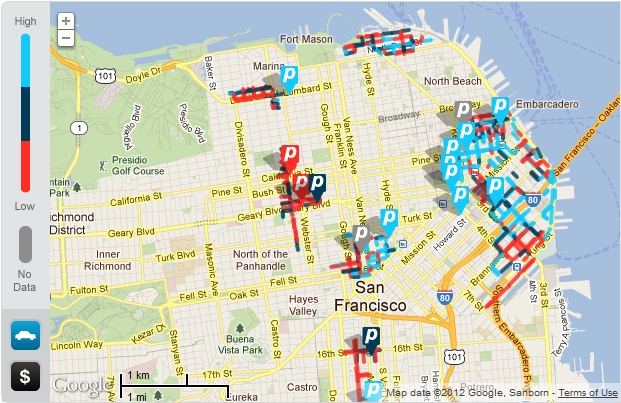 San Francisco, USA, was selected for using parking reform to great effect. The new SFpark variable-rate, demand-response parking management system provides real-time parking availability information online, via text and smartphone apps. The city’s ‘Pavement to Parks’ program reclaims parking spaces for public space and has created 20 new and dynamic parklets with more on the way. The city also started to upgrade and expand its bike network, setting an ambitious target of 20 percent of all trips made by bicycle by 2020.
San Francisco, USA, was selected for using parking reform to great effect. The new SFpark variable-rate, demand-response parking management system provides real-time parking availability information online, via text and smartphone apps. The city’s ‘Pavement to Parks’ program reclaims parking spaces for public space and has created 20 new and dynamic parklets with more on the way. The city also started to upgrade and expand its bike network, setting an ambitious target of 20 percent of all trips made by bicycle by 2020.
“San Francisco is really a model for how city governments can collaborate with different sectors to create immediate improvements to the environment, economic competiveness and overall well-being of a city,” said Heather Allen from the Transport Research Laboratory.
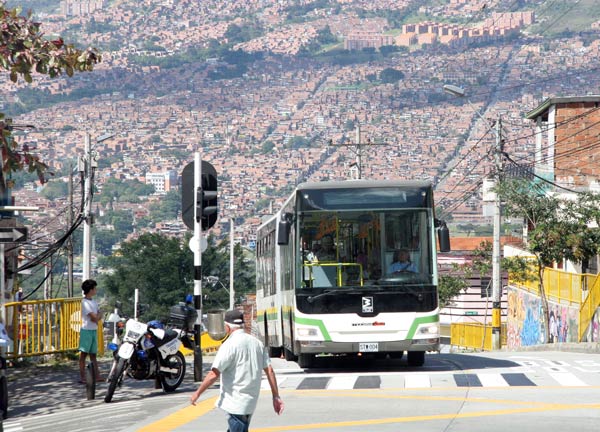 Medellin, Colombia, and its metropolitan area is being recognized for its public space improvements, and providing urban transport options to its citizens, such as its existing cable car and metro systems, and the recently inaugurated BRT project, Metroplús. The city created 1.6 million square meters of new park space through 25 parks and 11 urban promenades. Medellin also made progress with a new public bicycle program, EnCicla, that integrates universities and mass transit with popular city destinations; improved pedestrian crossings; and a ridesharing program, Comparte tu carro; as well as vehicle exhaust emissions controls and sulfur content improvements.
Medellin, Colombia, and its metropolitan area is being recognized for its public space improvements, and providing urban transport options to its citizens, such as its existing cable car and metro systems, and the recently inaugurated BRT project, Metroplús. The city created 1.6 million square meters of new park space through 25 parks and 11 urban promenades. Medellin also made progress with a new public bicycle program, EnCicla, that integrates universities and mass transit with popular city destinations; improved pedestrian crossings; and a ridesharing program, Comparte tu carro; as well as vehicle exhaust emissions controls and sulfur content improvements.
«Medellin pioneered the use of cable cars as a transit alternative in low-income informal settlements in hilly areas, moving 3,000 passengers per hour per direction; a real breakthrough now being replicated in Caracas and Rio de Janeiro,” said EMBARQ Director Holger Dalkmann. “The city transformed violence and despair into hope and opportunity, using sustainable transport as one of the key levers to drive change.”
Buenos Aires, Argentina, is receiving an honorable mention for opening the country’s first BRT system, Metrobús, and its comprehensive investment in cycling. In addition to opening the first bike share program in Argentina, the city has added more than 70 kilometers of bike lanes. Buenos Aires, recognizing that cycling infrastructure alone is not enough, has pursued a creative campaign around bicycle promotion. Together, this has resulted in a 120 percent increase in cycling in one year.
Sergio Sánchez, from the Clean Air Institute, notes that Buenos Aires’ “initiatives have had great impact in a short timespan and will continue to generate healthy air and other benefits for its people in years to come.”
Cape Town, South Africa, recently opened the first BRT system in Africa to integrate cycling. The MyCiTi integrated rapid transit network opened in May 2011 seeking to connect townships, a legacy of apartheid, to the downtown through a high quality service that is a model for its universal access and pedestrian access. The longest continuous bike way in Africa runs parallel to the BRT corridor. The city is expanding its bike lane network, with over 300 million rand (37.7 million USD) worth of projects being built.
“Cape Town has shown us how high-quality urban transport can be implemented in Africa,” said Manfred Breithaupt, title, German Technical Cooperation (GIZ). “It has some of the best practices in the region and will continue to.”
Sophie Punte, executive director of Clean Air Initiative for Asian Cities (CAI-Asia) applauded all four nominees, adding “Greening the city and encouraging walking and public transport also help to improve air quality. Air pollution is a major health issue in cities in developing countries, killing 1.1 million people prematurely worldwide each year.”
The Nominees were chosen by a Committee that includes the most respected experts and organizations working internationally on sustainable transportation:
- Clean Air Institute
- Clean Air Initiative for Asian Cities
- Deutsche Gesellschaft für Internationale Zusammenarbeit (GIZ) GmbH
- EMBARQ, the World Resources Institute’s Center for Sustainable Transport
- Institute for Transportation & Development Policy (ITDP)
- Transportation Research Board Committee on Transportation in Developing Countries
- Transport Research Laboratory (TRL)
- United Nations Centre for Regional Development (UNCRD)
The Sustainable Transport Award is presented each year in Washington during the annual meeting of the Transportation Research Board, one of six major divisions of the U.S. National Research Council.
Past winners of the Sustainable Transport Award include: Guangzhou, China (2011); Ahmedabad, India (2010); New York City, USA (2009); London, UK (2008); Paris, France (2008); Guayaquil, Ecuador (2007); Seoul, South Korea (2006), and Bogotá, Colombia (2005).
¿Comments? ¿Opinions? ¿Similar News? Send them to us!
Tweet
Opinion Pieces: How many buses could a heavy rail project buy?

Opinion Pieces: since 2007, Prof. David Hensher has written an opinion column in the Australasian Bus and Coach magazine, where he monthly discusses a lot of different transport-related hot topics. In this section we are revisiting these columns.
May 2011
Have you ever thought about how many buses could be purchased for the same amount of money invested in a major metropolitan rail project? Let us reasonably assume that heavy rail projects being proposed in some major metropolitan areas will cost $5billion, which in my view is conservative (given the Hensher rough rule of thumb to double the costs and you are close to reality), and that a single bus unit costs on average $350,000. Simple arithmetic suggests we could have on our roads an extra 14,250 buses. There are currently slightly less than 4000 buses operating the Sydney metropolitan area, so this would increase the total fleet to 18,250, or 4.56 times. Now what if there were two heavy rail projects? Our estimate is that we could buy 28,500 extra buses, increasing service capacity by 7.125 times. This is a huge (or maybe humungous) increase in service capacity that can be spread throughout an entire network and deliver huge benefits in terms of accessibility and mobility (in addition to jobs), which is unlikely to be the case for the single corridor rail project (or two rail projects). Such simple comparisons are never done, but surely it sends a strong message about where the potential benefits of public transport growth might be. Would this make traffic congestion worse? Yes if it had no impact on car use, but with an extra 28,500 (or even 11,400) buses it is hard to believe that they would not have significant impact on reducing car use, since such buses can really focus of connectivity and frequency, both of which are central to achieving the objectives of patronage growth (which has desirable financial and environmental outcomes), and coverage which delivers equity and social inclusion outcomes. Indeed a recent study by John Stanley, David Hensher and colleagues has shown that the major single benefit estimated to flow from Melbourne’s route bus services is the social inclusion benefit, which is valued at $A784m annually, or 43.5% of total estimated benefits.
Food for thought
¿Comments? ¿Opinions? ¿Similar News? Send them to us!
Tweet
Video: interview to Juan Carlos Muñoz (in Spanish)

The solution cannot be to make everything easier to car drivers.
Our transit system needs better infraestructure.
The government must not forget its regulator and coordinator role.
These are some of the ideas that Juan Carlos Muñoz, our Director, shared during an interview last week by 24 Horas, regarding mobility in Santiago de Chile. The topics adressed were urban highways, public transport, automobiles, etc.
Check the videos!
http://youtu.be/wx7qk4TTx_M
http://youtu.be/sb62ckIPVUY
¿Comments? ¿Opinions? ¿Similar News? Send them to us!
Tweet
A better service for Transmilenio: URGENT (in Spanish)

By Dario Hidalgo for El Tiempo
En la últimas semana de Marzo y la primera semana de Abril de 2012, TransMilenio fue objeto de protestas ciudadanas. Las protestas resultaron en bloqueos en la operación y vandalismo. Por ser parte del equipo que puso en marcha TransMilenio me duele mucho la destrucción que sufrió. Y me duele mucho más que TransMilenio esté prestando un servicio indigno, teniendo la posibilidad de volver a ser un sistema de clase mundial. Por allí debe comenzar la solución, y toda solución pasa por tres elementos: decisión política, fundamento técnico, y recursos financieros.
No hemos escuchado al Alcalde Gustavo Petro comprometiéndose de lleno con la solución de los problemas. No hemos visto al Secretario de Gobierno, a la Secretaria de Movilidad, a la Directora del IDU, y al Gerente de TRANSMILENIO S.A. declarando en forma conjunta que van a poner todo su empeño como administración distrital en mejorar la infraestructura y el servicio de TransMilenio. No hemos visto a los operadores privados comprometiéndose en hacer su parte; en ir un poco más allá del simple cumplimiento de los contratos, por el bien de los usuarios y el de sus empresas. Ese liderazgo es una condición necesaria.
La solución técnica pasa por múltiples elementos: reparación urgente de la infraestructura deteriorada, sobretodo en la Av. Caracas; replanteamiento de los servicios con servicios circulares más cortos en los tramos de mayor demanda; reconfiguración del uso de las estaciones para no tener tantos servicios en cada puerta y reducir la aglomeración; mejoramiento del control operativo para reducir el apiñamiento de los buses –que reduce sustancialmente la capacidad y la calidad de servicio; mejor coordinación de los semáforos con las necesidades de circulación; ampliación de estaciones críticas; construcción de troncales paralelas para reducir la carga, sobre todo en la Caracas; construcción de intersecciones a desnivel en las intersecciones críticas de la Caracas, Calle 13 y la Calle 80; y controlar el estacionamiento en las rutas alimentadoras, dotarlas de carriles prioritarios y mejorar su control, para facilitar el desplazamiento de los buses verdes. Sólo traer buses es insuficiente.
También se requiere volver a la educación ciudadana y la promoción de lo positivo; y es bienvenida la participación de los propios usuarios en las soluciones: construyendo no destruyendo. Y muy importante: terminar bien la Fase III y comenzar la expansión de las troncales de la Av. Boyacá y la Av. 68, retrasadas ya más de cinco años con respecto al plan original.
Y con respecto a la plata, es necesario asignar los recursos para planear y ejecutar estas iniciativas. El plan de desarrollo tiene algunos recursos asignados ¿serán suficientes? También es posible abaratar el costo del servicio licitando la operación de nuevos buses, especialmente para reemplazar los de la Fase I que ya están llegando al millón de kilómetros. El llamado es a la acción, no solo a la discusión. TRANSMILENIO S.A. conoce bien estos temas y ha trabajado para ir haciendo algunas de estas cosas, pero sin liderazgo del propio Alcalde, sin trabajo conjunto con Gobierno, Movilidad y el IDU, y sin plata no se soluciona nada.
¿Comments? ¿Opinions? ¿Similar News? Send them to us!
Tweet
Lessons for Indore: study tour of Ahmedabad's Janmarg

Source: EMBARQ
Experts exchange best practices of bus rapid transit in Indian cities.
EMBARQ India organized a comparative study tour of Janmarg, the bus rapid transit system (BRTS) in Ahmedabad, with officials from Atal Indore City Transport Services Ltd. (AICTSL).
EMBARQ India organized the study tour to Ahmedabad, home to one of the most successfully implemented BRT systems in India, to give the AICTSL team the opportunity to witness the benefits of the BRT system and to help them understand the issues faced during implementation, the design changes that enhanced performance, operations and monitoring, contracting procedures, and Intelligent Transport Systems (ITS).
As a result of the study tour, AICTSL is looking to improve the infrastructure of its own buses, depots and workshops in Indore. The Mayor of Indore approved the construction of 21 BRT stations on the AB Road pilot corridor, totaling 11.8 kilometers in length. The construction work has started and is expected to finish in six months.
The city agency also plans to custom-make the buses similar in design to the Janmarg buses, which would reduce the cost of buses by 20 percent and expedite the delivery of buses by three months. In addition, AICTSL plans to implement the gross cost model, which would mean greater connectivity to areas with low ridership, as opposed to operators choosing only profitable routes if they used the net cost model.
EMBARQ India continues to engage with AICTSL in providing knowledge, guidance and expertise as the city implements the project.
AICTSL runs Indore’s bus systems and currently operates 107 buses on 16 routes in the city. The agency is slated to further expand the network into rural areas and towns around Indore. AICTSL is responsible for the planning, management and implementation of the bus service, while private operators are in charge of bus operations. AICTSL will be the implementing agency for the BRTS pilot project.
Study tour participants:
- Dr. Gautam Singh, Joint Collector & CEO (AICTSL), Govt. of Madhya Pradesh
- Rahul Shrouty, Technical Manager, AICTSL
- Mohammad Irfan, Accounts Manager, AICTSL
- Sandeep Trivedi, Operation Manager, AICTSL
- Prashanth Bachu, Project Manager-Urban Transport, EMBARQ India
- Tabrez Syed, Associate-Urban Transport, EMBARQ India
¿Comments? ¿Opinions? ¿Similar News? Send them to us!
Tweet
New safer buses for Transantiago (in Spanish)

Source: SIBRT
Buses nuevos cuentan con sistemas LED de iluminación, aviso de parada por altavoces y sistemas de conducción segura.
Mejorar la calidad del servicio prestado y las condiciones de los buses en circulación fue el compromiso del Ministro de Transportes y Telecomunicaciones, Pedro Pablo Errázuriz, cuando el 22 de octubre pasado comenzó a operar la francesa Redbus en la zona norte de Santiago.
Hasta ese minuto, el transporte público en las comunas de Huechuraba, Quilicura, Renca, Recoleta, Independencia y Conchalí era prestado por Buses Gran Santiago, empresa que se declaró en quiebra en abril pasado y que durante los últimos meses operó con graves deficiencias en frecuencia, regularidad y mantención de los buses.
“A dos semanas del cambio de operador en la zona norte de Santiago ya podemos ver los primeros cambios reales al servicio que reciben las personas. Redbus comenzó la incorporación de buses nuevos, modernos y de una tecnología que garantiza seguridad a usuarios y pasajeros”, destacó el Ministro de Transportes y Telecomunicaciones, Pedro Pablo Errázuriz.
Los nuevos buses, que beneficiarán a 166 mil usuarios de Recoleta, Huechuraba, Renca, Conchalí, Independencia y Quilicura, cuentan con un sistema de conducción segura inédito en Chile. Ello, porque las nuevas máquinas incorporan un sistema de alerta a los conductores cuando exceden la velocidad permitida o realizan maniobras peligrosas para los pasajeros, dejando registro de esas situaciones que pueden afectar fuertemente a los usuarios.
Adicionalmente, los nuevos buses tienen un sistema de iluminación interior LED, que asegura una mayor visibilidad, evitando los espacios oscuros al interior del bus. Además, se trata de los primeros vehículos del Transantiago que informan al conductor por altoparlantes cuando se solicita una parada, especificando si ella fue requerida por un usuario en silla de ruedas, lo que implicará un mejor servicio para las personas.
Los 50 nuevos buses requirieron una inversión de US$ 10 millones y actualmente 8 de ellos ya están en circulación en Huechuraba y Recoleta.
En una primera etapa, estos buses están circulando en el recorrido B16 que une el sector de El Carmen de Huechuraba con el Metro Vespucio Norte en Recoleta.
El Ministro Errázuriz manifestó que “así como Redbus demuestra con la incorporación de estos nuevos buses su compromiso por mejorar la calidad del servicio en el norte de Santiago, esperamos que el resto de las empresas replique esta y otras iniciativas que vayan en beneficio directo de sus usuarios”.
Además, el ministro hizo un llamado a las personas a cuidar esta nueva infraestructura del Transantiago que va en directo beneficio de todos los usuarios.
¿Comments? ¿Opinions? ¿Similar News? Send them to us!
Tweet
Visiting TransMilenio with Prof. Swamy, the Brains Behind Ahmedabad’s BRT System

Source: The City Fix by Dario Hidalgo
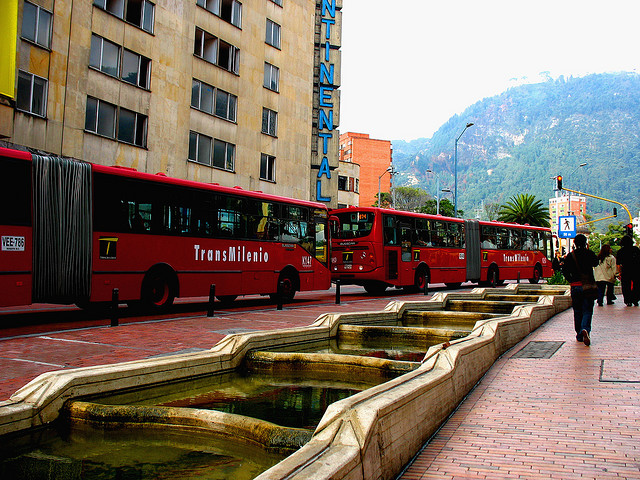
Eje Ambiental, translated as the «environmental axis,» is now a prominent part of TransMilenio’s BRT system. Photo by Lauro Oliveros.
Prof. Shivanand Swamy, a faculty member specializing in public transit planning and bus rapid transit (BRT) at the Center for Environmental Planning and Technology (CEPT) University in Ahmedabad, India visited Bogota, Colombia on November 15-19, as a speaker at the fifth annual International Fair of Mass Transport, organized by Corferias and TRANSMILENIO S.A.
Prof. Swamy has been providing direct advice to the Ahmedabad Municipal Corporation on the design and operation of the award-winning Janmarg system, the first full BRT system in India. Janmarg adapted several concepts introduced in Latin American BRT corridors to the local conditions of Ahmedabad’s urban characteristics and user needs.
I had the privilege of traveling the TransMilenio system with Prof. Swamy and answer many of his questions regarding infrastructure design and operations. The visit also gave me the opportunity to experience corridors and areas of the city that I do not have the chance to visit often. This is a short description of our trip.
Exploring the City
We started the “safari” in the historic downtown, in a facility known as “Eje Ambiental” (“environmental axis.”) It used to be a small river and was buried in a tube in the early 1930s to build Avenida Jimenez, one of the first two-lane arterials of the city. Between 1997 and 2001, Avenida Jimenez was converted into a transit mall, just for pedestrians and buses. Three stations of the TransMilenio BRT system were opened in 2001, connecting the busy Avenida Caracas busway with the east section of downtown. The area has many universities and government institutions, demanding many transit trips.
We entered the TransMilenio system in the terminal station of Las Aguas and headed west through Avenida Jimenez/Calle 13 and Avenida Americas busways. Avenida Americas was the first expressway in the city, built in 1946 to connect the airport and downtown. It has a very wide right-of-way and goes to one of the most dense residential areas of the city, Kennedy, named after the president of the United States, who inaugurated a residential development in this area in 1960. We passed through an intermediate integration station called Banderas, close to a monument of the same name, which has the flags of all the American states that met in Bogota in 1948 to create the Organization of American States. The busway connects with Avenida Cali to reach the America’s Portal, the busway terminal in the west of the city. It is a very large terminal, connecting feeder and regional buses, and side-by-side with one of the seven bus depots of the 84-kilometer system. It has a very heavily used bike parking facility for 1,500 bikes, showing some intermodal integration.
While Avenida Americas is wide, Avenida Cali is narrow (only 40 meters), with just room for two busways lanes, two general traffic lanes and a very busy bikeway, which has the largest concentration of cycle rickshaws in the city (just as in some areas in Ahmedabad.) The area is middle- and low-income. Close to the terminal is a CADE, a one-stop shopping place for citizens to do business with official local, regional and national entities (i.e. to pay utilities, pay taxes, file complaints, obtain permits, etc.)
We took a feeder bus to Metrovivienda El Porvenir, a social housing complex with full urbanism (paved roads, well designed sidewalks, bikeways, parks, schools and social services, and even retail.) It shows a sharp contrast with the surrounding neighborhoods, which still have unpaved roads and a lack of sidewalks (despite some interventions by the city.)
A Great Example
It was quite an interesting trip. We even had the opportunity to talk with passengers on the buses who were surprised to see an Indian professor go to the extremes of the city to study TransMilenio and the housing complex. They welcomed us and informed us that this was the best neighborhood of the city. We returned to downtown in a busy express bus, full of night college students.
I experienced the good, the bad and the ugly in the current TransMilenio system. The “good” was the fast, convenient ride and the very short wait. Given that we used an express service we covered 25 kilometers in just 40 minutes. We had the opportunity to see people with disabilities easily using the system because of TransMilenio’s compliance with accessibility regulations. It was also good to see the “complete streets” with sidewalks and bikeways along the way. There were some issues with the maintenance of the road and the plaza outside of America’s Portal.
The “ugly” was the very high occupancy of the buses reaching downtown and the delay to cross Carrera 10, now under construction to be turned into a new trunk way. I just hope the new city administration looks carefully at these issues and works to improve and expand the TransMilenio service. Despite the few necessary improvements, TransMilenio is still one of the most amazing mass transit references for transit planners like Prof. Swamy.
¿Comments? ¿Opinions? ¿Similar News? Send them to us!
Tweet
Event wrap up: General Assembly

The General Assembly was very well attended and proved to be a great success, as previous years. We had the visit of Måns Lönnroth and Anders Brannstrom from VREF who showed their satisfaction with the work shown and the progress reached. We also had several advisors and key invited people to the Assembly, as Lake Sagaris, Sam Zimmermann, Gerhard Menckhoff, Fernando Páez, Federico Van Buchwald and Brendan Finn. We had several students, CoE researchers and EMBARQ staff actively participating. The feedback received was very useful and will be considered as input for research in following years.
Photo:
Top row: Orlando Strambi, Federico Von Buchwald, Toni Lindau, Juan Carlos Munoz, Mans Lonnroth
Middle row: Haris Koutsopoulos, Anders Brannstrom, Brendan Finn, Juan Miguel Velasquez, Vasco Reis, Chris Zegras, John Attanucci, Andre Cademartori, Amit Bhatt, Julian Arellana, Jose Viegas, Gerhard Menckhoff, Dario Hidalgo and Sam Zimmerman
Last row: Romulo Orrico, Brenda Medeiros, Anna Matias, Rosario Macario, Lake Sagaris, Daniela Faccini, Bianca Bianchi Alves
Ricardo Giesen, Aileen Carrigan, Luis Gutierrez, Fred Salvucci, Salvador Herrera also participated in the meeting but unfortunately skipped the picture.
These were the projects presented during the meeting:
- Development of a Global BRT Database PDF presentation
- BRT Busways and Traffic Safety PDF presentation
- LS1 Assessing the Performance of BRT Systems – Econometric Modelling and Case Studies PDF presentation
- LS2 Exploring the Complexity of Policy Design PDF presentation
- LS3 BRT from vision to promise to delivery PDF presentation
- LT1 Development, calibration and validation of bus-following model to support analyses and evaluation of alternative BRT strategies under different scenarios PDF presentation
- LT4 Analysis of High-quality Bus Services in Larger Developed Cities PDF presentation
- LT5 Modeling reliability, cost, travel times, safety, comfort and other relevant variables of modal choice PDF presentation
- LO1 Explore innovative ways to manage and control BRT services PDF presentation
- E1 Assessment of Needs in Training and Educational Gaps PDF presentation
- BHLS Bus with High Level of Service PDF presentation
¿Comments? ¿Opinions? ¿Similar News? Send them to us!
Tweet
Transantiago: Better than before, but a long way to go (in Spanish)

Source: La Tercera by Juan Carlos Muñoz
El Transantiago que se visualizó hace unos ocho años no es demasiado distinto al que se observa hoy. Si el 2007 se hubiese inaugurado lo que tenemos actualmente el plan no hubiese sufrido el gran trauma inicial. Entre los principales logros del sistema está la empresarización del sector, la formalización laboral de los conductores, la integración tarifaria, el pago con una tarjeta sin contacto y el fin de la guerra por el pasajero. Son logros cuantiosos que muchas ciudades en el mundo quisieran alcanzar. Sin embargo, el inicio fue durísimo. El big-bang debió evitarse y se debió considerar la necesidad de subsidios. Se lanzó el Transantiago sin la infraestructura ni los sistemas de gestión necesarios y eso es un error infantil que nos causó gran desprestigio. Adicionalmente, incentivos perversos para las empresas gatillaron la debacle inicial. Lamentablemente, aún se carece de infraestructura adecuada en corredores y estaciones de parada y se ofrece un nivel de servicio irregular. Quizás uno de los elementos más preocupantes es la elevada evasión tarifaria. Este es un cáncer que se debe enfrentar y destruir. Resulta preocupante, pues sus consecuencias éticas trascienden el ámbito del transporte público. Transantiago requiere un subsidio que no fue parte de su diseño inicial. Para su sustentabilidad Santiago necesita un sistema de transporte público que requiere un financiamiento mayor al que los propios usuarios pueden pagar. Ignorar la necesidad de estos subsidios significaría llevar a la ciudad en un camino de debacle que debemos impedir. Las bases están instaladas y la ciudad debiera observar mejoras sucesivas si las autoridades toman las acciones correctas.
¿Comments? ¿Opinions? ¿Similar News? Send them to us!
Tweet
The UN recommends BRT systems to improve urban movility (in Spanish)

Source: SIBRT
El modelo BRT (Bus Rapid Transit) fue reportado por un estudio realizado por la Organización de las Naciones Unidas (ONU) como una solución exitosa a la movilidad urbana, y que también ha sido adoptada por varios países en el mundo. El hallazgo se presentó en el informe: “Hacia una Economia Verde – Formas de Desarrollo Sostenible y Erradicación de la Pobreza”, que forma parte del Programa de las Naciones Unidas 2011.
La solución de los carriles exclusivos para buses, con un comportamiento similar al del metro, ya fue adoptada en Curitiba y en la Región Metropolitana de Sao Paulo. En la ciudad de Paraná, la reducción del consumo de combustible después del BRT fue del 30%. El sistema utilizado en Sao Paulo ya cuenta con buses híbridos, además de corredores verdes que absorben una parte de los contaminantes emitidos.
Otro caso que demuestra la eficiencia del sistema, se encuentra en Bogotá, Colombia, donde las emisiones de contaminantes se han reducido en un 14%. Además de la capital colombiana, otras ciudades que adoptaran el BRT son: Lagos – Nigeria, Ahmadabad – India, Guangzhou – China, Johannesburgo – Sudafrica, e Zurich – Suiza.
En el estudio, la ONU resalta la importancia de las acciones del gobierno para promover la movilidad urbana sostenible. “La distribución de la inversión en el transporte tendrá un rol crucial en el proceso para evitar o restringir infraestructuras con altas emisiones de carbono en la próxima generación”, dijo la organización en el informe.
También de acuerdo con la ONU, el transporte en los centros urbanos, es responsable de casi la mitad del consumo de combustibles fósiles en el mundo y todavía representa aproximadamente el 25% de las emisiones de CO2, relacionadas con la energía liberada en la atmósfera. En lo que se refiere a cuestiones económicas, la inversión en transporte sostenible se traduciría en un ahorro del 10% del PIB y un aumento en el número de puestos de trabajo del 10%.
¿Comments? ¿Opinions? ¿Similar News? Send them to us!
Tweet
Bus Rapid Transport System is key to urban development: Saugata Roy

Source: The Hindu Business Line
Kolkata, Nov. 11, 2011: The Union Minister of State for Urban Development, Mr Saugata Roy, on Friday said that bus rapid transit system (BRTS) projects were key to urban development in the country.
BRTS is typically low-cost, flexible, mass transportation system. “BRTS projects have been highly successful internationally and come at one-tenth the cost of metro projects,” Mr Roy said while speaking at urban renewal and transport summit organised by the Indian Chamber of Commerce here today.
The Centre will focus on the development and promotion of public transport systems, including metro railways, across the country to meet the increasing need for an improved and efficient transit system. The government will support projects for metro railways in cities with population of over 20 lakhs.
The urban renewal process in the country will throw up a funding requirement of Rs 39 lakh crore in the next 20 years, he pointed out. The government also plans to set up dedicated urban transport authorities. “There should be city specific strategies, greater private sector participation, capacity creation and concerted efforts from all stakeholders towards the revival of the transport sector,” Mr Roy said.
BRTS in Kolkata
The BRTS project from Ultadanga to Garia along EM Bypass in Kolkata was approved by the Centre last year and the work will progress soon, said Mr Firhad Hakim, the State Minister for Urban Development.
Kolkata BRTS, to be executed by the Kolkata Metropolitan Development Authority, is a Rs 250-crore project. “The State government will fund about 50 per cent,” he said.
Beginning at Ultadanga, the route will cover 15.5 km running along the E M Bypass to Garia. The corridor will connect major growth centres such as Sector V, Rajarhat, Salt Lake, and Patuli Township.
There was a paucity of competent workforce in the State for designing and implementing its urban renewal projects. “We need more institutes which will adopt a pragmatic and realistic approach towards the issues related to urbanization to bridge the skill gap in the State,” he said.
¿Comments? ¿Opinions? ¿Similar News? Send them to us!
Tweet
Opinion Pieces: Is it a carbon price or a carbon tax?

Opinion Pieces: since 2007, Prof. David Hensher has written an opinion column in the Australasian Bus and Coach magazine, where he monthly discusses a lot of different transport-related hot topics. In this section we are revisiting these columns.
April 2011
There is so much confusion out in the real world about whether we will get a carbon tax or a price on carbon. It is time for a lesson in language and clarity.
Prime Minister Julia Gillard is reportedly determined to fight on with her carbon tax proposal despite a new poll showing Labor’s primary vote has hit rock-bottom. Labor’s primary vote plunged to 30 per cent in the early March poll, with the Coalition leading 54 to 46 per cent in two-party terms, although Labor rebounded a week later.
There are clear sensitivities out there in the real world, which in many ways may be attributable to a lack of clarity in simple language as to what is planned, not helped by the repetitive reference to ‘another big tax’ by the Federal opposition.
In clarifying the language, let me begin with a distinction between a ‘tax’ and a ‘charge’ and then move onto a ‘price’. A ‘charge’ is a sum that is calculated to reflect the cost of resources consumed that need paying for by the beneficiaries of this consumption. It is often related to the idea of paying for a negative externality such as the creation of carbon dioxide (CO2) as a direct or by-product of the act of an individual, household or business. By imposing a charge, Government is, on behalf of society, recognizing this negative externality and ensuring that those who create it pay for it. Once we have identified the appropriate level of the charge (which is a challenge in itself), then imposing it is equivalent to internalizing the negative externality so that it is no longer an externality, since it is now being paid for by those who created it.
There are a number of ways in which we can establish the right level for this charge, and this is where the confusion abounds. As a prelude, however, we must now be clear what a tax is. We all know it is a sum of money the government takes from us; however it often includes two components – a sum to represent the cost of resources consumed (for petrol this is the opportunity cost of the oil resource), plus a sum that is on top of this amount which government chooses and which is nothing more than a means to raise revenue to be used as the government wishes. (Heavy vehicles (including buses) are charged an amount that represents road damage costs, mainly recovered through the excise but also partly through registration. They get a rebate of the rest of the excise). Government typically imposes the revenue raising component on activities where the market is far less price sensitive (e.g., cigarettes and alcohol and fuel), since we typically are addicted to the consumption of these items, and have in many situations little choice (which includes using the car).
So now we should understand that there exists a price that government adds onto the cost of consumption (and production) that can be a mixture of a charge and a tax, which in the current context of a carbon tax is associated directly with the externality element. The biggest challenge is how to determine this price in terms of some reasonable objectives such as economic efficiency and fairness, given in the case of CO2 the desire to clean up the environment. If it all works out well, we would expect the price to be an incentive to look at alternative measures to achieve the desired outcomes of households and businesses, while at the same time reducing CO2.
The discussion thus far is designed to help in understanding some of the language used by economists and policy commentators (including some politicians); however from the real politics of pricing carbon, there are two ways to identify a price. Through a carbon tax/charge or through establishing a carbon price. A Government, where it supports a price determination, will establish a carbon price through some market mechanism, which is often referred to as an emission trading scheme (ETS). Alternatively a carbon tax (or charge) can be explained (justified) as the charge for the externality. The tax sets a price on carbon and consumption leads then to a level of emissions. An ETS operates in reverse: it sets the level of emissions and a price (tax or charge) for carbon results, consistent with this level of emissions.
Under ETS, trading takes place in a market for carbon (credit and debits), with an announced cap on the amount of emission reduction to target (hence cap and trade), which should, if markets are efficient (or close to efficient), deliver a market price for a unit of carbon. This is then the carbon price, which pundits can then claim is the efficient level of a carbon tax. Imposing a carbon tax without ETS does not ensure the equivalent price on carbon.
The challenge with the ETS is that we need efficient markets, or dare I say a market of any level of efficiency, to get started. They do exist in parts of the world (notably Europe and California); however it is unclear how Australia might enter that market. At the end of the day, it is the rate of emissions reduction that will be critical and that is an argument in favour of an ETS, where targetting is clear (but able to be captured by the rent seekers – who will probably capture the tax too). If the tax is set too low, emissions will not fall quickly enough and the tax will need to be increased. Research undertaken for ‘Climate Works’ at Monash University by McKinsey suggests a 25 percent cut in Greenhouse Gas Emissions by 2020 would require a marginal price of about $50/t CO2, which is what we might reasonably expect to see by 2020. A starting price might be about half this estimate.
The ‘debate’ and ‘noise’ in Federal Parliament is very much connected to what this ‘right’ price might be. Although politicians and their advisers are unlikely to know the price, they do have a right to announce such a price – that is what they get elected to do – operationalise social value judgments on tough calls. As a consequence (or for other reasons that elude me), politicians have moved away from an ETS (The Rudd preference), and started promoting a carbon tax (often mixing the language with a carbon price), with plans to announce the level of tax ($/kg of carbon). Curiously, a carbon tax is highly correlated with the cost of fuel in car and heavy vehicle uses (being the product of fuel price, fuel efficiency (litres per 100km) and kilometres travelled). Research I have undertaken using the TRESIS software developed at my Institute, suggests we might be just as effective in reducing CO2 (if the only route is a carbon tax) to ‘quietly’ hike up fuel excise, which is expected to have almost the same effect on transport users, avoiding the emotion attached to a carbon tax, although the downside is that it may not send the right message to the market to develop alternative products with less carbon. I doubt governments have fallen over a higher fuel excise, but they may just fall over a carbon tax, possibly for all the wrong reasons.
So what we appear to have now is a carbon tax at a level not yet announced (as of March 24 when this thought piece was written), which we are told is a transition to a carbon price under an ETS. Exactly how we can transition is a bit of a mystery, since the carbon tax will not create a market for carbon, although it should signal responses from the market to make changes in services and technology to reduce CO2, and hence the impost of the carbon tax.
I am however reminded that a switch to clean fuels (those with no carbon content), which is what government wants to encourage through a tax or a price on carbon, could in the long run erode the revenue base of government, who I predict will introduce another tax on these alternative fuels as a way of establishing revenue. Time will tell, but for now readers might benefit by the clarification of language
Food for thought
I acknowledge the substantial comments of my colleagues Professors Corinne Mulley and John Stanley who have helped to ensure the language is clear.
¿Comments? ¿Opinions? ¿Similar News? Send them to us!
Tweet
Workshop on road safety in São Paulo brings together main agencies managing municipal urban public transportation in Brazil

Source: SIBRT
Latin American Association of Integrated Systems and BRT (SIBRT) holds the first of a series of events that discusses actions to improve road safety for public transit bus systems.
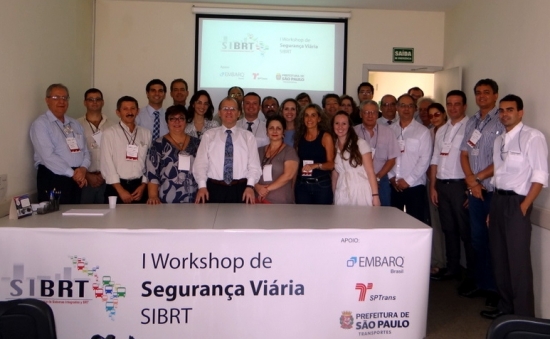 The I SIBRT Road Safety Workshop, held in the city of São Paulo from February 8-10, brought together the main agencies managing municipal urban public transportation in Brazil. As many as 28 experts from Belém do Pará , Belo Horizonte, Canoas, Curitiba, Campinas, Goiânia, Porto Alegre, Rio de Janeiro and São Paulo, presented their activities in road safety, and discussed problems and opportunities to reduce fatal accidents in the exclusive BRT (Bus Rapid Transit), corridors and Integrated Transport Systems (ITS).
The I SIBRT Road Safety Workshop, held in the city of São Paulo from February 8-10, brought together the main agencies managing municipal urban public transportation in Brazil. As many as 28 experts from Belém do Pará , Belo Horizonte, Canoas, Curitiba, Campinas, Goiânia, Porto Alegre, Rio de Janeiro and São Paulo, presented their activities in road safety, and discussed problems and opportunities to reduce fatal accidents in the exclusive BRT (Bus Rapid Transit), corridors and Integrated Transport Systems (ITS).
Sponsored by SIBRT and EMBARQ Brazil, and supported by SPTrans, the meeting advanced the discussion of issues relating to road safety in the cities of Latin America, which now carry more than 20 million people daily. Luis Antonio Lindau, President of EMBARQ Brazil, expressed his concern for both pedestrians and motorcyclists. “In Brazil, most people involved in accidents are pedestrians and motorcyclists. It is important to note that public transportation users are also pedestrians. We need to distinguish between public transit riders who are on their way to or from the transit system, and include in our analysis not only the rider as a public transit user, but also as a pedestrian,» said Lindau. He also highlighted the importance of the meeting as an opportunity to present lessons learned and share them among other management entities of urban public transportation.
The experience of São Paulo – now with a fleet of 15,000 buses – was showcased through four presentations by technical staff from SPTrans and Traffic Engineering Company. Curitiba (the pioneer city in ITS and BRT and a reference for urban mobility advancement around the world), Belo Horizonte, and Porto Alegre, also presented their experiences and challenges in road safety. Also presented were results of research done, by EMBARQ Brazil’s Road Safety team, on security of BRT systems in the world and lessons learned in several BRT projects in Brazil. «It was an opportunity to exchange experiences and try to seek uniformity in city data collection and analysis, in order to have comparable indicators that serve as more efficient references,» stated Rosângela Battistella, advisor to the President of the URBS, Curitiba.
The technicians, divided into working groups, analyzed information and experiences of agencies with the intention to reach concrete proposals and improve Road Safety. Issues like collection and analysis of data, institutional integration, signaling and infrastructure, education and educational campaigns, and surveillance systems were discussed at the working groups. «This format is very productive. People are not just here to say what they want, but rather to listen and discuss in depth about road safety. It is very valuable for the exchange of experiences, and an efficient and intelligent work methodology, «said Pedro Luis Machado, Technical Director of SPTrans. With extensive experience in participating in technical events, Machado values meetings focused on a single theme, in which participants have the real opportunity to interact and discuss further.
“Bringing together experiences from agencies and organizations with unique responsibilities in traffic safety will certainly provide benefits to other agencies through sharing of experiences and lessons learned from the EMBARQ’s research and audits in discussion during the workshop,” said Operations Director of BHTrans, Daniel Marx Couto. «Some cities have more experience in road safety issues, which can reduce the work in other agencies. Benchmarking is an important tool in facilitating the work of public agencies,» stated Couto.
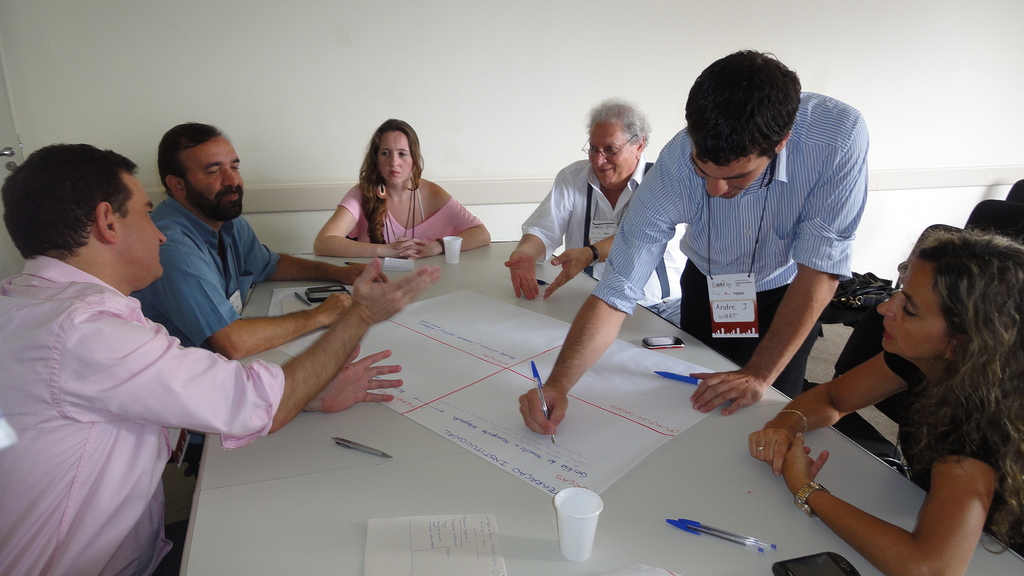 With this event, SIBRT opens a path to permanent cooperation with Brazilian agencies with respect to road safety. Additionally, it is also possible to apply best practices for considerable reduction of accidents, and to achieve specific goals proposed by the World Health Organization for the Decade of Action for Road Safety. «When comparing systems, it is possible to see both strengths and weaknesses. Another point was the possibility to exchange knowledge and experiences,» said Maria Cristina Molina Hill, Technical Director of EPTC, Porto Alegre.
With this event, SIBRT opens a path to permanent cooperation with Brazilian agencies with respect to road safety. Additionally, it is also possible to apply best practices for considerable reduction of accidents, and to achieve specific goals proposed by the World Health Organization for the Decade of Action for Road Safety. «When comparing systems, it is possible to see both strengths and weaknesses. Another point was the possibility to exchange knowledge and experiences,» said Maria Cristina Molina Hill, Technical Director of EPTC, Porto Alegre.
Luis Ricardo Gutierrez, Executive Secretary of SIBRT and Latin America Strategic Director for the EMBARQ Network, said that this event was made possible as a result of the support from SPTrans and funding from Bloomberg Philanthropies. «We need to emphasize the participation of SPTrans, that presented how the teams act during different stages of the bus systems operations – such as information, data analysis, driver training, and guidance to pedestrians,” said Gutierrez. He also stated that “the valuable experience of São Paulo presented along with cities such as Belo Horizonte, Curitiba, and Porto Alegre has enabled us to reflect and draw conclusions for development of proposals, and improvement of effective bus systems in Brazil and Latin America. The Bloomberg Philanthropies’ support was crucial to this event. »
The final results of this work will be presented at the II «SIBRT Best Practices in Latin America» Conference to be held from April 25-26 in the city of León, Mexico. The goal is to share this information with other agencies in Latin America, in order to multiply the scope of efforts and reduce accidents in urban public transport systems.
¿Comments? ¿Opinions? ¿Similar News? Send them to us!
Tweet
Event wrap up: Transforming Transportation 2012

Source: Anson Stewart’s website
Last week, transit leaders from around the world converged on Washington, D.C. for Transforming Transportation 2012. The two-day event, hosted by EMBARQ, The World Bank, Inter-American Development Bank, Asian Development Bank, Institute for Transportation Development and Policy, Clean Air Initiative for Asian Cities, and the Partnership for Sustainable Low Carbon Transport, included a number of speakers suggesting ways to scale-up sustainable transportation systems.
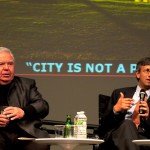
“City is not a problem, City is a solution” – Manish Bapna, the Acting President of the World Resources Institute, and Jaime Lerner discuss scaling up urban transportation innovations.

Jaime Lerner, the mayor of Curitiba who successfully “metronized the bus,” sitting in front of this graph showing the explosive growth of bus rapid transit systems worldwide.

Jaime Lerner describes his “urban acupuncture” approach. A video with highlights from his keynote address is available here.
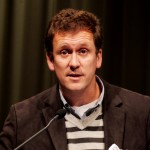
Juan Carlos Muñoz, Professor at the Catholic University of Chile and the Director of our Centre of Excellence.

Lake Sagaris, Head of Communications, Innovation and Development for Ciudad Viva and a member of the ALC-BRT Advisory Board.
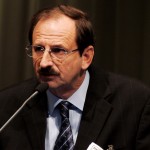
Federico von Buchwald, President of the Metrovía Foundation and Vice-President of SIBRT, presents on Guayaquil’s BRT system.
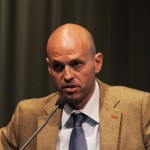
Guillermo Dietrich, Undersecretary of Transportation for Buenos Aires, presents on the municipal government’s Sustainable Mobility Plan.
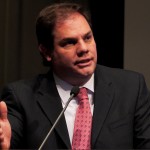
Mauricio Facio Lince Prada, Secretary of the Municipal Government, Medellín.
¿Comments? ¿Opinions? ¿Similar News? Send them to us!
Tweet
In a Failure of Municipal Ambition, Plans for Detroit Light Rail Shut Down as Focus Shifts to BRT

Source: The Transport Politic
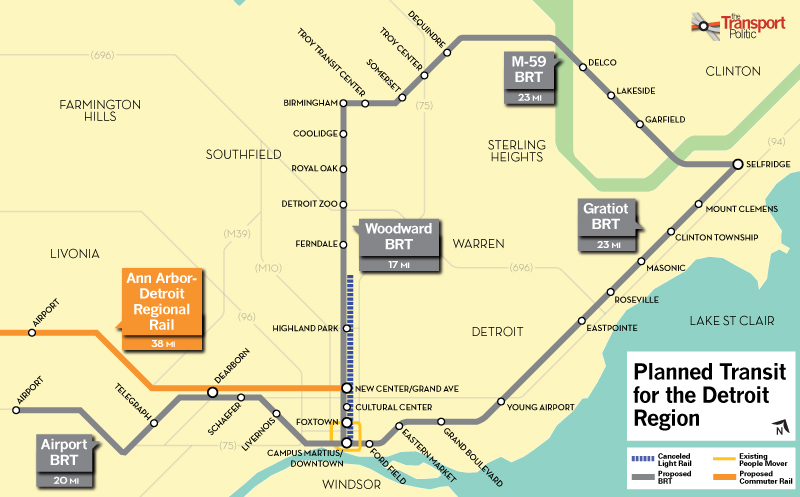
In early 2010, the U.S. DOT announced that it would award a $25 million TIGER grant to Detroit to begin construction on a new light rail line along that city’s central spine. For two years, hope spread through America’s most notorious shrinking city: This project, perhaps, would provide the boost to resurrect the Motor City.
Last week, just as the latest TIGER grants were being unveiled for other cities, local leaders announced they would reneg on that promise due to a fear that operations costs would be impossible to cover. A less aesthetically pleasing — but far more extensive and regionally funded — BRT program would be inserted in its place.
This situation speaks two realities: First, Detroit continues to be a mess — both politically and financially. Leaders of surrounding counties have shown themselves unwilling to compromise, expressing hostility over the idea that local tax funds might go to aid the transportation system adjacent city rapidly descending into zombie mode. Second, the U.S. DOT rushed its initial selection of TIGER grant recipients and showed that it was incapable of following through. Detroit’s fiscal situation in 2010 was not much better than it is today; how could the government have expected the city to fund the project’s operating costs then if it can’t now?
For Detroit’s civic ambitions, the death of the $528 million light rail plan is devastating news. Over the past two years, as it has become increasingly apparent that the current situation is far from sustainable, business, political, and community leaders have staked their hopes for the future of the city on the rail project. Not only would the 9.3-mile transit line running up Woodward Avenue provide substantially improved access to downtown, they argued, but it would spur a major increase in development in the area. Mayor Dave Bing suggested that the population of the city would be encouraged to relocate to more transit-accessible neighborhoods, especially along the corridor. The light rail line would give the city a competitive advantage.
This outlook was never realistic: No rail project, no matter how nice, can singlehandedly reverse the systematic decline of a once-huge city. Development will come to downtown Detroit when there is a demand for housing units and employment there, not when there are tracks along Woodward Avenue. Moreover, the city’s existing employment-housing imbalance, in which 60% of the city’s job holders go to the suburbs for work, means that a downtown-focused project would likely be ineffective in resolving the commuting needs of many people.
The decision to cancel the project, however, came down to the fact that Washington was worried that the City of Detroit would be unable to subsidize the costs of operation. The city’s existing transit services are in turmoil: The downtown People Mover, a one-way automated elevated loop line, practically shut down this month due to a lack of agreement about funding it. Fewer than half of the city’s buses are in operation, due to neglect and maintenance issues. Suburban bus services, offered by SMART, have declined considerably faced with less-than-expected revenues. To make matters worse, there is little fare or service integration between the three operations.
The Federal Transit Administration expressed concern that the situation could get even worse if the light rail line’s operations costs required the elimination of some bus services. Several months ago, FTA head Peter Rogoff argued that Detroit’s goal to use annual state and federal grants as the primary source of funding was an untenable long-term approach.
But an alternative providing a steady revenue source would require regional cooperation, and indeed the government hoped that the Detroit region would integrate its transit offerings into a single regional authority. Yet disagreements across county lines have imperiled the concept of a regional transit authority repeatedly; a $600 million effort to build a regional rail system in the 1970s, for instance, was scuttled when surrounding counties refused to join in. Oakland County Executive L. Brooks Patterson argued against a regional transit tax this summer and in fact has been a stated proponent of, as he says it, sprawl.
The new bus plans, serving surrounding Macomb and Oakland Counties as well as Detroit’s Wayne County, apparently will relieve that tension because, unlike the light rail efforts, they would not be focused on the central city’s downtown. The regional transit authority is again being promoted, this time by Michigan Governor Rick Snyder.
Four BRT corridors would run 83 miles between the region’s largest destinations. 34 stations would connect downtown with the airport, Birmingham, Troy, and Selfridge, primarily along Woodward Avenue, Gratiot Avenue, Michigan Avenue, and M-59. The extensiveness of the network as proposed will provide a level of service an order of magnitude more significant than would have the light rail.
The project is in the earliest stages of planning, so the levels of service to be offered by this BRT network are unclear. How many exclusive lanes will be provided for the buses, for example?
This proposal is similar to the 67-mile “Golden Triangle” announced by suburban leaders in Spring 2010. Yet while that less-lengthy plan would have cost about $800 million, Governor Snyder has suggested that this new BRT network, referred to as the “Metro Connection Tri-County Triangle,” could be built for $500 million. That price seems too low for 83 miles of exclusive busways — and it certainly would not allow for particularly ornate stations. Meanwhile, the state legislature must still approve a regional funding plan if the project’s operations costs are to be covered.
Let it be clear: Even if the BRT project provides a lot more services than the light rail for a similar capital cost, its operations costs will be far higher. Under the existing legislation, in which the federal government is prohibited from providing operations support for transit services, the only way this project will get off the ground is if the suburban counties agree to massive increase in transit funding. That may seem like an unrealistic prospect, but it is probably more feasible than assuming suburbs would agree to fund the operations costs of a city-only rail line.
None of these funding dilemmas have prevented private and non-profit supporters of the rail project, who had collectively submitted $100 million for the line, from complaining about the needs of the downtown. They suggest that a 3.2-mile line, costing $225 million and running from the river to New Center, could be funded with federal New Starts funding. Yet the U.S. DOT seems to have made clear that there will be no dollars for light rail in Detroit.
Meanwhile, Mayor Bing, unfortunately, continues to use fantastical rhetoric when it comes to promoting the BRT system: “With Detroit’s rich history of innovation,” he wrote in the Free Press, “There is no doubt we can build a system that competes with other successful BRT lines in Cleveland, Pittsburgh and Los Angeles.” Yet the development of the BRT plan should have little to do with competition; its primarily purpose must be to serve the transit-dependent population of the city. Will it get the chance to do so, or relegated to the dustbin like most other transit plans for Detroit?
¿Comments? ¿Opinions? ¿Similar News? Send them to us!
Tweet
Lima presents video surveillance system for Metropolitano corridor (in Spanish)

Source: SIBRT
La Municipalidad Metropolitana de Lima presentó las 384 modernas videocámaras que han sido instaladas a lo largo del corredor del Metropolitano para brindar mayor seguridad a los usuarios de este sistema de transporte.
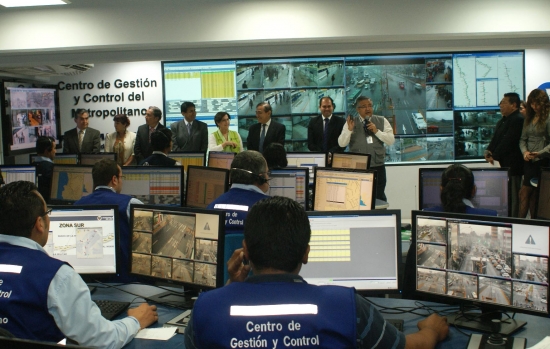 Los equipos fueron adquiridos por la comuna a través del Instituto Metropolitano Protransporte de Lima, por cerca de 6.5 millones de soles.
Los equipos fueron adquiridos por la comuna a través del Instituto Metropolitano Protransporte de Lima, por cerca de 6.5 millones de soles.
Durante la presentación de este moderno sistema de video vigilancia, considerado el más grande del Perú, la alcaldesa de Lima, Susana Villarán de la Puente, señaló que la instalación de cámaras modernas en todo el corredor también contribuirá a tener un control de la operación y del tránsito en la ruta del Metropolitano.
“En esta gran línea de fibra óptica que va desde Matellini (distrito de Chorrillos al sur de Lima) hasta el Naranjal (distrito de Independencia al norte de Lima), hemos colocado 384 cámaras de video vigilancia que nos permiten ver dentro de las estaciones y en el entorno para brindar mayor seguridad, así como para tener un control del tránsito en toda la zona del Metropolitano”, señaló la burgomaestre.
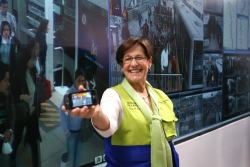 Todas las cámaras, entre las que se encuentran 54 de alta definición, son monitoreadas desde el Centro de Gestión y Control que se ubica en el local de Protransporte. Igualmente, personal especializado de la comuna metropolitana, supervisa cualquier situación desde la Estación Central y los terminales de Naranjal y Matellini. En caso de ser necesario, también se puede realizar el monitoreo desde equipos móviles.
Todas las cámaras, entre las que se encuentran 54 de alta definición, son monitoreadas desde el Centro de Gestión y Control que se ubica en el local de Protransporte. Igualmente, personal especializado de la comuna metropolitana, supervisa cualquier situación desde la Estación Central y los terminales de Naranjal y Matellini. En caso de ser necesario, también se puede realizar el monitoreo desde equipos móviles.
Este sistema inteligente incluye además un subsistema de central de monitoreo, el cual tiene la capacidad de realizar análisis de video inteligente en las demás cámaras, como puede ser el conteo de personas, la detección de ingresos por zonas prohibidas, detección de robos de activos fijos y la detección de objetos abandonados, entre otras acciones que pueden ayudar en la prevención de accidentes y otros sucesos en las zonas aledañas al Corredor del Metropolitano.
Además, los estándares de calidad de este sistema garantizan la integración con módulos de Sistemas de Seguridad Electrónica, como los que detectan incendios y controlan los accesos de vehículos a zonas exclusivas para los buses del Metropolitano.
Distribución estratégica
Las cámaras han sido distribuidas de la siguiente manera:
• 186 en el Tramo Sur.
• 105 en el Tramo norte.
• 68 en el Tramo Centro.
• 25 en las intersecciones para análisis de video.
Interconectar sistemas
La alcaldesa de Lima, Susana Villarán, anunció que se dialogará con el Ministro del Interior, para que interconecten las cámaras de la Policía Nacional del Perú con el sistema de video vigilancia del Metropolitano, como una contribución de la comuna metropolitana a la seguridad ciudadana.
Asimismo, invitó a los alcaldes de los distritos de Lima que están invirtiendo en la instalación de fibra óptica, a interconectarse al sistema de video vigilancia del Metropolitano. “El alcalde de Los Olivos ya ha mostrado su interés en interconectarse para hacer una gran maya que sirva para la protección del ciudadano en la ruta del Metropolitano y en las calles, así como para atender otros temas de seguridad ciudadana”.
¿Comments? ¿Opinions? ¿Similar News? Send them to us!
Tweet
The Design of Public Transport Maps

We uploaded the PhD Thesis of our member Jose Allard, called The Design of Public Transport Maps – Graphic elements and design operations in the representation of urban navigation systems (2009) for you to download it!
Abstract: Public Transport Maps are probably one of the most common forms of graphic communication (Avelar, 2002) and certainly one of the most recognizable cartographic items in the world (Ovenden, 2005). They are present in most developed urban areas and help million of users to navigate through their cities every day. Public Transport Maps have become effective visual tools for communicating spatial concepts and presenting navigation information –such as routes direction, transport modes, stations, connections, landmarks, etc.– through a particular graphic language and design techniques.
Designers’ recognition and control over this language and techniques not only affects the visual characteristic of the map and the users interaction with the network, but also their interpretation of the city and other contextual conditions. Perhaps, for these reasons -and despite several attempts from computer science and transport authorities to automatize and normalize their construction- the design of most Public Transport Maps still relays on designers’ criteria.
The following thesis presents the main design issues regarding the conceptualization and graphic construction of Public Transport Maps through several case studies. It pretends to identify the different aspects and elements that should be considered in their design and how they are graphically represented.
The first part of this thesis introduces and contextualizes Public Transport Maps as a complex communication artifact through two emblematic cases: London’s Underground map and New York’s subway diagram. Afterwards, it looks at the main conditions that shape their design, such as the transport system, the user, the context and the mapmaker.
The second part examines the elements, attributes and graphic operations commonly symbolized by mapmakers worldwide, through a comprehensive survey of international cases. It also establishes an analytical framework based on cartographic and typographic principles that may support design processes of Public Transport Maps and further studies on the subject.
The third part presents insights regarding the construction of Public Transport Maps and compiles guidelines and recommendations for those involved in this process.
It finally synthesize above observations reviewing the design process of a Public Transport map recently developed.
This thesis pretends to support mapmakers in their graphic decisions and make a contribution to the current multidisciplinary discussion on the field, from the point of view of a practicing designer.
Full document link here
¿Comments? ¿Opinions? ¿Similar News? Send them to us!
Tweet
New data confirm European transportation habits are much greener than those in US cities

Source: Kaid Benfield’s Blog in Switchboard NRDC
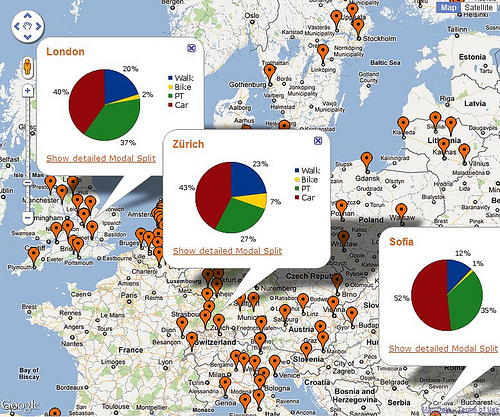 It is no secret that the United States is one of the most car-dependent cultures in the world. In data from 17 countries published by The National Geographic Society in 2009, only five percent of Americans surveyed used public transportation daily, and only seven percent reported taking public transportation at least once a week. 61 percent of Americans reported that they never use public transportation.
It is no secret that the United States is one of the most car-dependent cultures in the world. In data from 17 countries published by The National Geographic Society in 2009, only five percent of Americans surveyed used public transportation daily, and only seven percent reported taking public transportation at least once a week. 61 percent of Americans reported that they never use public transportation.
Internationally, however, 25 percent of respondents reported using public transportation daily, and 41 percent reported using it at least once a week. In both cases the international sample was five times or more as likely to use transit as Americans. Even Canadians are more than twice as likely to report weekly or more transit usage than Americans; Russians are over ten times more likely. shopping center parking lot, suburban virginia (by: Mrs. Gemstone, creative commons license)In another part of the study, Americans were found to walk or bicycle regularly only half as much as the full international average.
For the US, I reported some city-by city comparisons of commuting habits based on 2008 data. As would be expected, New Yorkers were the most likely to take transit to work (54.8 percent) and the least likely to drive alone (23.3 percent). Washingtonians were number two in both categories (35.7 percent and 37.2 percent, respectively). Residents of Boston and Washington were the most likely to walk to work (14 percent and 12 percent). At the other end of the spectrum, fewer than one percent of residents of Oklahoma City take transit to work. Collectively, an overwhelming majority of American city residents (74 percent) drive alone to work.
A new, interactive website launched by the European Platform on Mobility Management displays easily retrieved data for individual European cities. (The Platform is a network of European governments, represented through their transport ministries and organized as an international nonprofit organization headquartered in Brussels.) Not all European cities are represented (at least not yet), but many are. For example, here’s what I found just looking at the three cities shown on the map at the top of the post:
- The share of walking trips as a portion of the total is about twice as high in London and Zurich as in even the top American cities;
- New York’s transit share compares favorably to those of the three European cities, but five to seven times as many residents of London, Zurich and Sofia use transit regularly as do Americans as a whole;
- A majority of residents prefer driving only in Sofia, and there only 52 percent do, as compared to 74 percent of residents in typical larger American cities.
The good news is that analysts now have a convenient new source to turn to for comparative data on transportation habits in various cities. The bad news, for Americans, is that our own transportation habits are environmentally pathetic by comparison, using far more oil, emitting far more carbon, and requiring far more expensive infrastructure, than those of Europeans. Unsurprising, I suppose, but not exactly uplifting. We are moving in the right direction, it seems, as I wrote yesterday, but we have a lot of catching up to do.
The European database appears very much a work in progress. There are important cities yet to be included (Rome, Barcelona), and some of the interactive features are clunky. Eric Britton of World Streets points out some of the limitations in an article introducing the system, though he is positive as to its usefulness and potential. There are ways for users to submit additional data. But the site is already useful and interesting, and likely to get better over time.
¿Comments? ¿Opinions? ¿Similar News? Send them to us!
Tweet
Chicago Will Let Buses Ride the Shoulder to Beat the Rush

Source: The Atlantic Cities
When the going gets tough on Monday in Chicago, the buses will get going. The city is introducing a pilot program that will allow buses to use the shoulder on the Stevenson Expressway (Interstate 55) to avoid rush-hour traffic. The effort will go into effect for two bus routes that connect the southwest suburbs of the city to the downtown area and the Illinois Medical District:
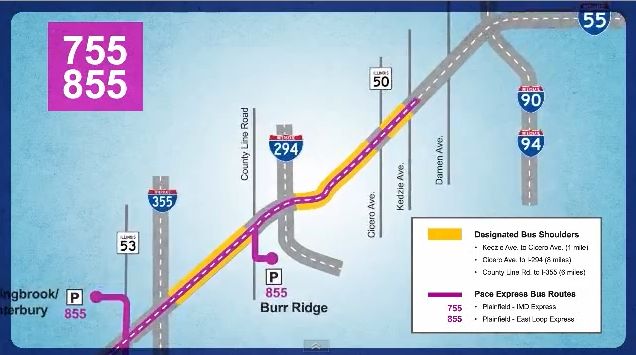
Courtesy Illinois Department of Transportation
On the surface, Chicago’s «Bus on Shoulder» program sounds like a fairly radical plan. Actually, a number of cities across the country – including Washington, D.C., Seattle, Miami [PDF], Atlanta, Columbus [PDF] and others – have implemented similar efforts over the past 20 years. The practice isn’t limited to the United States either. Toronto, Vancouver, Dublin and Auckland have all let buses traverse their highway shoulders in recent times. As cities struggle to fund transit projects, and search for low-cost alternatives as a result, bus-on-shoulder programs stand to grow in popularity.
The premise behind the programs is to improve travel times in key transit corridors, thereby reducing congestion and encouraging people to ride public transportation. Creating a dedicated bus lane isn’t a possibility on many urban highways. By giving buses a way around tight traffic, officials are helping improve the reliability of the travel mode.
That not only satisfies bus riders, it also has the potential to attract drivers. As one recent Federal Transit Administration report [PDF] on bus-shoulder programs around the world put it:
The marketing and psychological message of buses passing motorists stuck in traffic congestion tends to be powerful.
… Although the actual speed was only 5 to 15 mph faster than the adjacent automobile traffic depending on the traffic conditions at a particular location on the route, the impression passengers get is of a much faster speed because they see themselves passing so many cars.
Chicago’s program is modeled on a similar effort that’s been operating for decades in Minneapolis-St. Paul. The Twin Cities adopted the idea on a six-lane highway in 1991, and liked it so much they expanded its reach by 10 to 30 miles a year. At the end of 2006 the Twin Cities had 271 miles [PDF] of active bus-shoulder lanes, roughly 10 times the rest of the country combined, with more planned for the future.
As the growing mileage suggests, the Twin Cities program has been a great success. A study from the late ’90s found that overall bus ridership increased 9 percent in areas with bus-only shoulder lanes — at a time when transit ridership was down 6.5 percent systemwide. Other program reviews have reported a travel savings of around seven minutes during rush hour. During inclimate weather, particularly heavy snows, that savings increases to nine minutes.
Of course there are some ground rules. The buses are only allowed on the shoulder when the general highway flow drops below 35 miles per hour during peak-congestion periods. They must adhere to a maximum speed of 35 or 15 mph more than the neighboring congestion — whichever is slower. So if traffic grinds to a halt on the Stevenson on Monday, buses can cruise the shoulder at 15 until either it passes the congestion or the other lanes get moving again. (The 35 mph limit was introduced by the Twin Cities program after officials piled bus drivers into a room and asked them how fast they felt safe driving on the shoulder. At 40 mph some started to note their discomfort, so 35 mph it was.)
Initially the use of shoulders for bus traffic raised some legitimate safety concerns. If buses are cruising the shoulders, there is less room on the highway for disabled vehicles, emergency personnel, and construction staging. In bus-on-shoulder programs, cars can still pull into the shoulder for emergency purposes, and buses have to manuever around them. A greater concern is shoulder width. Many urban highway shoulders are only 10 feet wide — nearly the width of most buses. The tight fit often worries drivers in neighboring lanes, a fear that’s already surfaced among Chicago car commuters. But the history of bus-shoulder programs shows a solid safety record. In the past 10 years, there have been only 20 accidents involving buses involved in the program, and the only damage has been to property, according to the Minnesota Department of Transportation.
As far as bang for the taxpayer buck, the bus-shoulder programs are hard to top. The per-mile cost of implementation has varied in the Twin Cities. If a shoulder is wide enough to handle buses and its drains are in good shape, the cost can run as low as $1,500 a mile; if shoulders must be widened and repaved, and lanes re-striped, the costs can creep toward $66,000 a mile, topping out near $100,000. But even that top range compares favorably with other transit options: light rail construction runs in the tens of millions, and even bus-rapid transit in the low millions. There are some additional costs for signage and bus-driver training. But overall bus-shoulder projects are remarkably cost-effective.
Chicago has seen all the potential in previous bus-on-shoulder programs, and raised them. Pace, which operates the buses for the Chicago program, is upgrading its coaches in the corridor to include amenities like upholstered seats, bike carriers, and even free Wi-Fi. The company hopes to double its ridership, largely by attracting drivers onto the bus. «Right when you’re filling up your car, putting $30 or $40 in, we’ll give people an alternative,» a director told the Chicago Tribune. «‘Maybe I will take this bus downtown.'»
¿Comments? ¿Opinions? ¿Similar News? Send them to us!
Tweet
Two awards from MIT-Chile Seed Fund

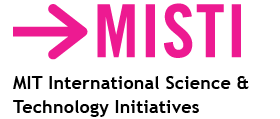 MISTI’s newest program, MIT-Chile, launched fall 2011, connecting MIT students & faculty with companies and research opportunities in Chile. Find more information here.
MISTI’s newest program, MIT-Chile, launched fall 2011, connecting MIT students & faculty with companies and research opportunities in Chile. Find more information here.
A special Seed Fund for collaborations with PUC was opened, to which of course we applied. We are very glad to announce that two of our applications were accepted. These are the summaries of the projects presented:
Urban Public Transport Operations Control
Members: Nigel Wilson, Juan Carlos Muñoz
Summary: Increasing use of automatic data collection systems in transit systems is providing significant potential for improving service quality both in terms of service planning and operations management. However this potential has yet to be fully realized because prior research approaches have failed to fully appreciate the multiplicity of objectives and constraints facing controllers in the real world. This has resulted in overly simplistic model formulations which are not acceptable to operating organizations. In the proposed collaboration Professors Wilson and Munoz with graduate students at MIT and PUC will develop a general framework for addressing operations control problems in transit networks and demonstrate this framework in a range of settings including single bus and rail lines, with and without branches, and simple networks which allow for passenger interchanges. The objectives to be included within the framework relate to customer service quality, including both travel time and its reliability, and to the operator’s cost. Significant constraints to be included are the current locations of in-service and other available vehicles, the location and availability of crews with their working restrictions and the availability of infrastructure which are needed for various real-time interventions. The requested MISTI seed funds will be used to fund trips by both faculty and graduate students for working meetings among the team members and with transit agencies interested in applying the results of this collaboration in Boston, Santiago and London.
Implementing Bus Rapid Transit: Institutional Dimensions
Members: Christopher Zegras, Manuel Tironi
Summary: This project aims to critically assess the implementation procedures and implications of a particular form of large scale urban transportation intervention that has been increasingly pursued by developing and developed country urban decision makers: bus rapid transit (BRT). BRT aims to emulate more up-front-capital-intensive rail-based urban transportation systems on key performance characteristics, but with a relatively low-cost, rapid implementation, and a high degree of flexibility. While undoubtedly transforming mobility systems in many parts of the world, BRT is still a disruptive intervention. Our objective is to understand, from the planning policy and sociological perspectives, these large-scale engineering projects. Specifically, we aim to understand the consequences of the natural tensions that will arise between project proponents and groups from civil society, particularly neighborhood and environmental groups and incumbent transportation operators. To this aim, we will examine two recent, but quite different, BRT implementations in two Latin American capital cities: Transantiago, in Santiago de Chile; and Metrobus in Mexico City. These cases exemplify two very different modalities of BRT implementation and management. Their comparison, therefore, will bring new insights into the understanding and planning of BRT in Latin America and the global south at large.
¿Comments? ¿Opinions? ¿Similar News? Send them to us!
Tweet
V International Mass Transport Fair

The V International Mass Transport Fair is the meeting place for suppliers, manufacturers, representatives and distributors of equipment, supplies, machinery and technology in the sector to make qualified contacts and exchange experiences, transfer knowledge and share products and services.
This event, uniting managers, planners and operators of mass transport systems through the world, seeks to create opportunities and alternatives for sustainable development of integrated public transport systems.
During this year’s event, held in Bogota, Colombia, on 16-18 November, Juan Carlos Muñoz presented a seminar regarding the challenges of intermodality when integrating public transport systems. This subject is especially relevant these days in Bogota, when the city is facing its own system integration.
You can download the presentation here (in Spanish).
¿Comments? ¿Opinions? ¿Similar News? Send them to us!
Tweet







